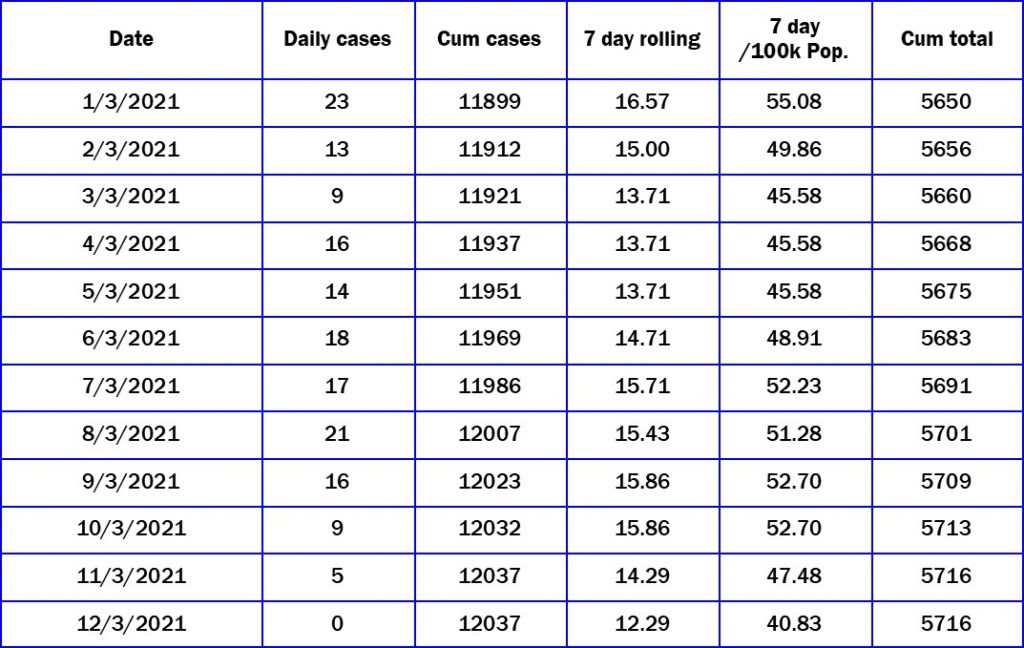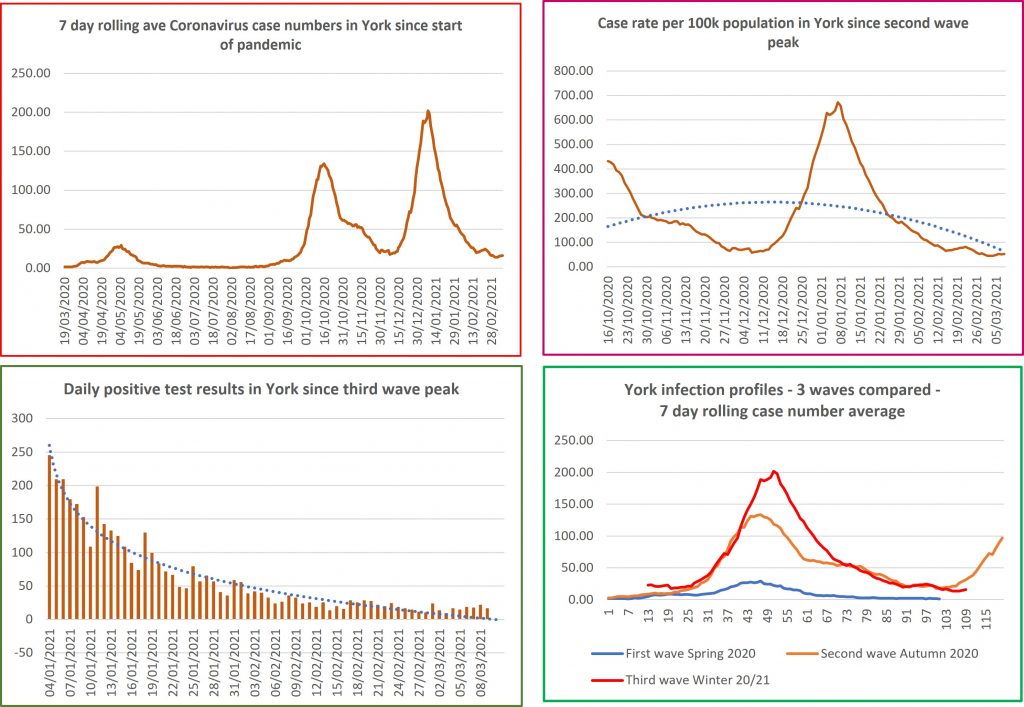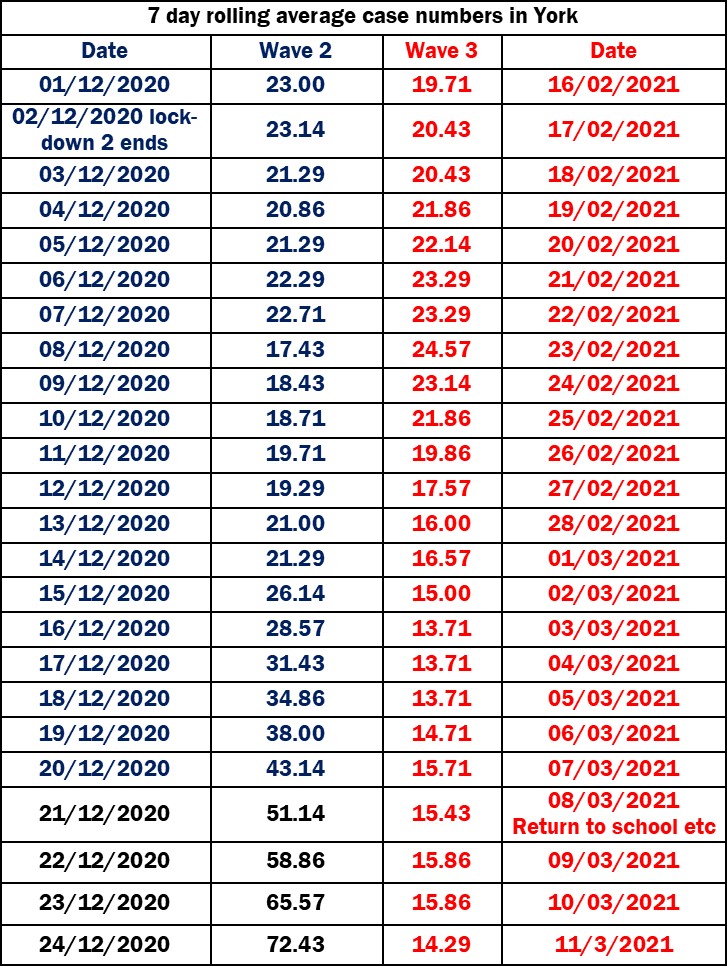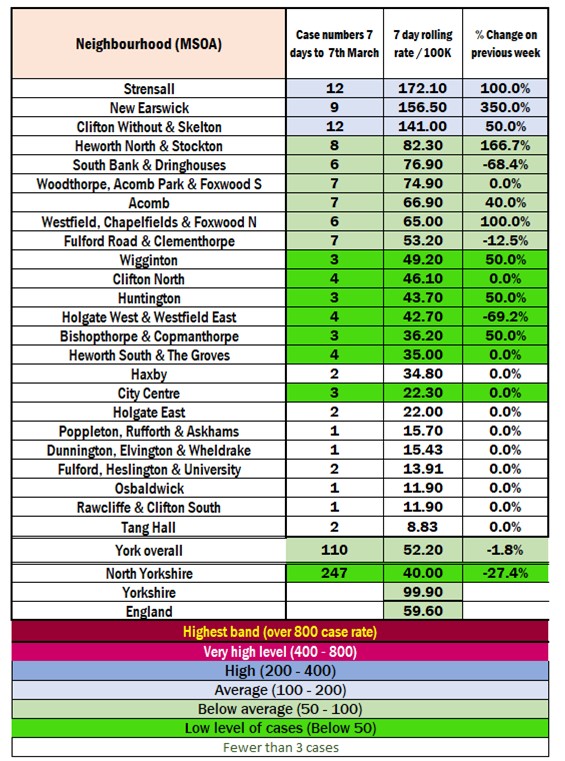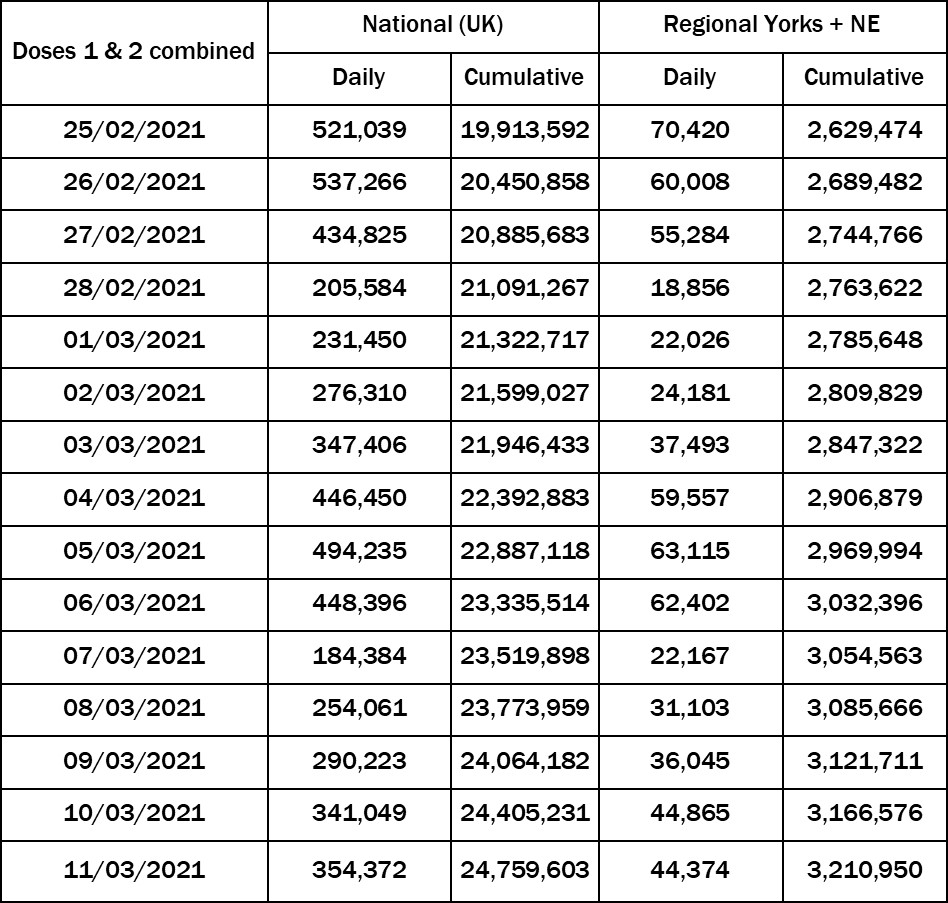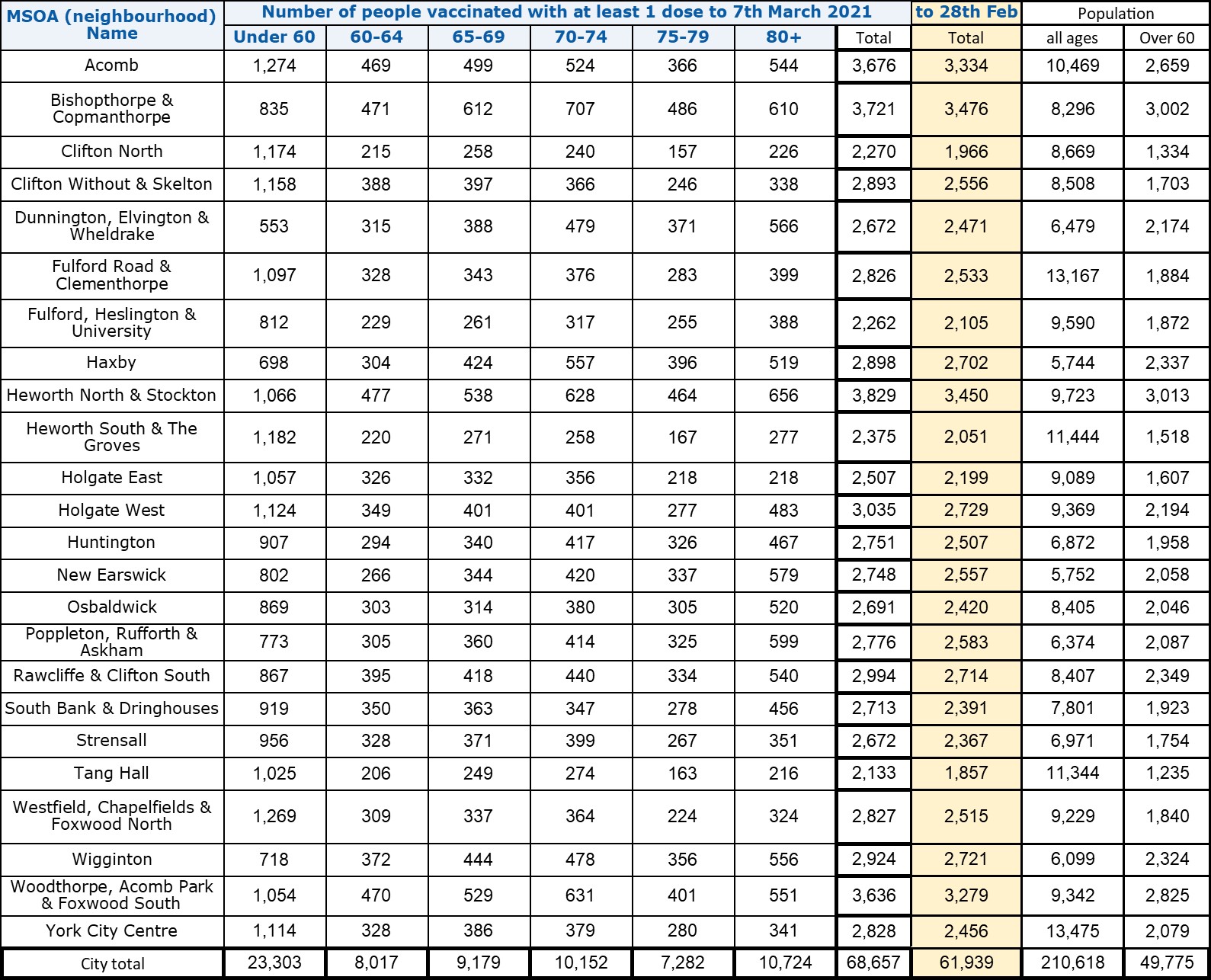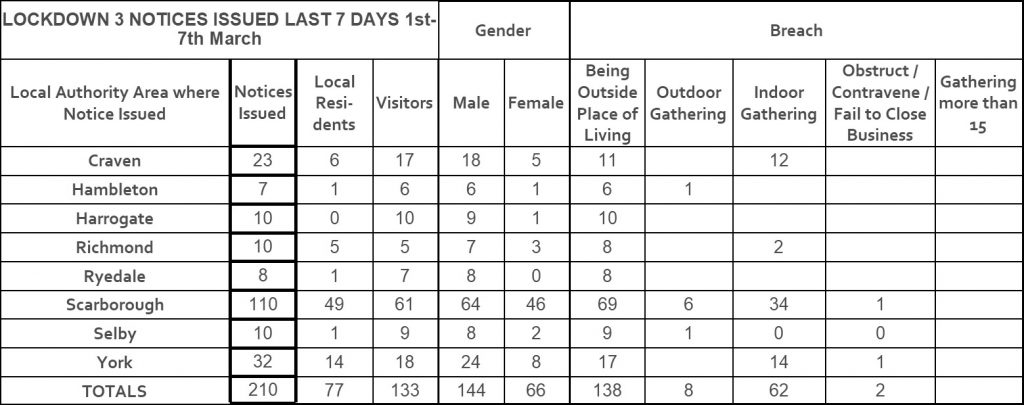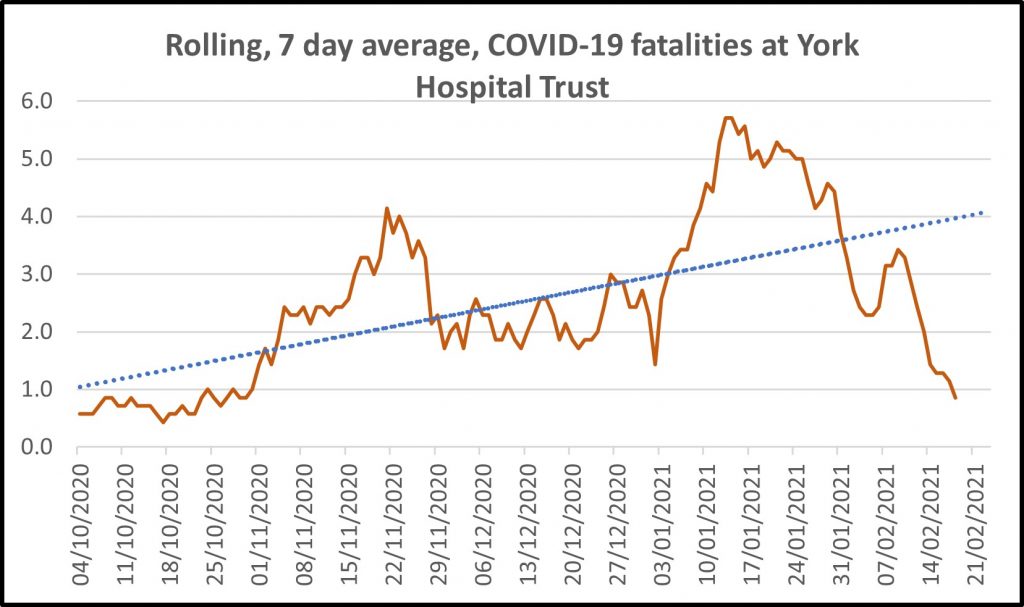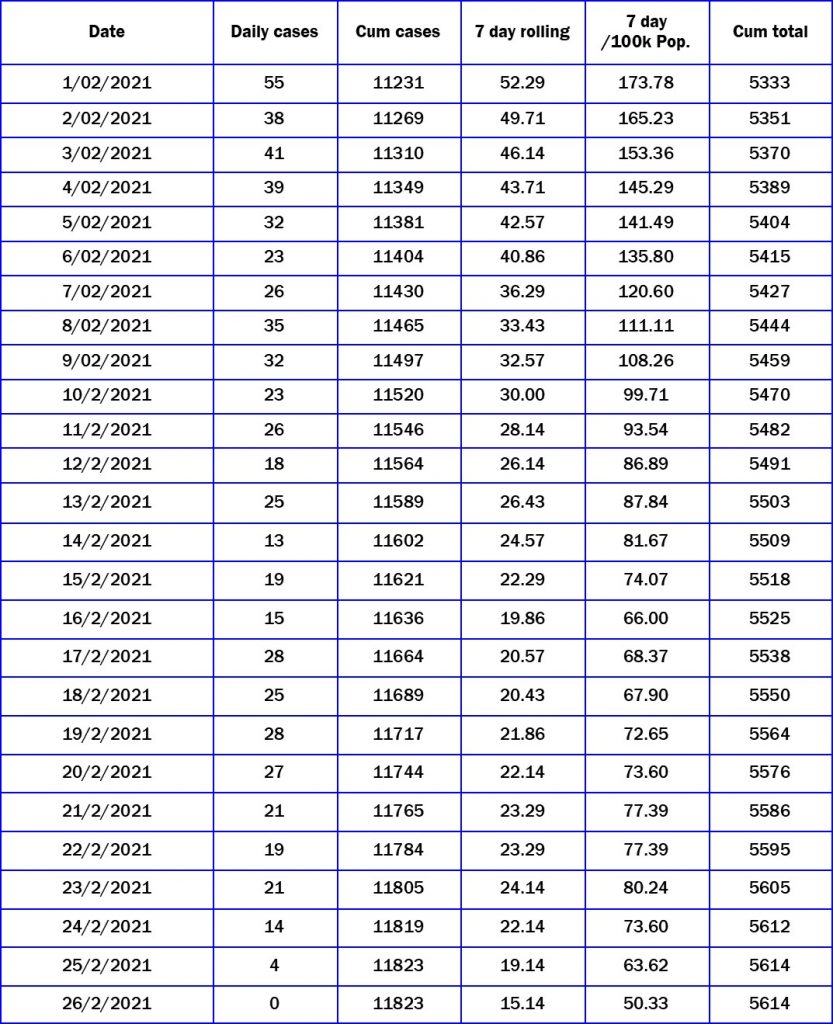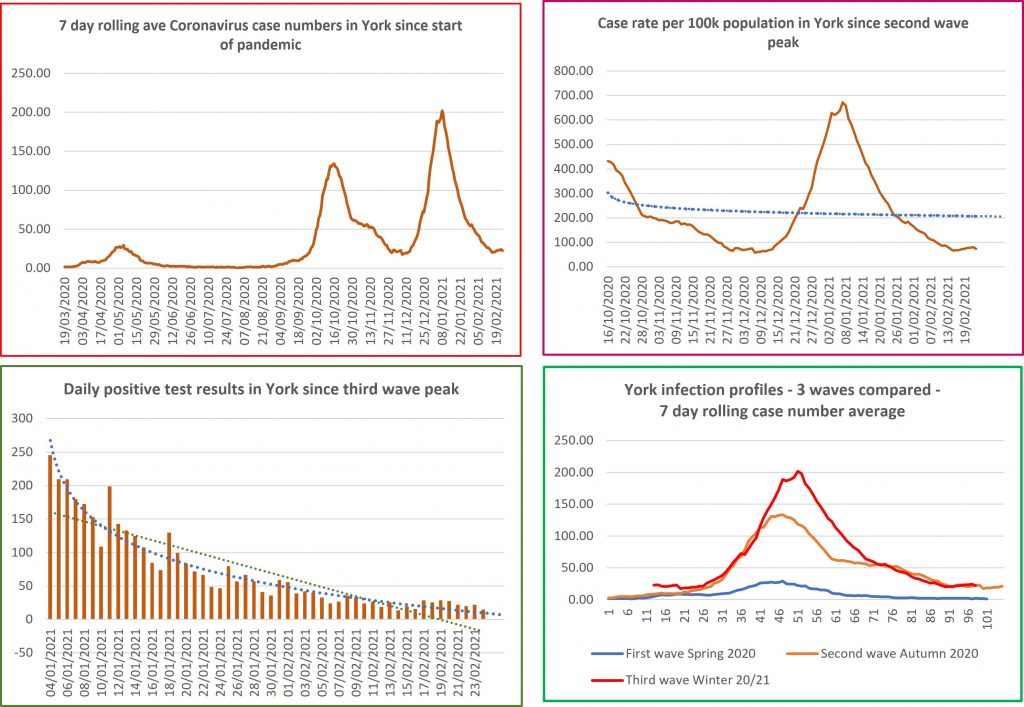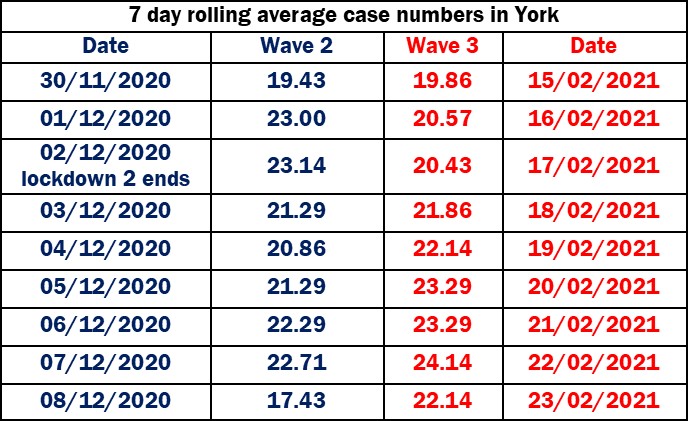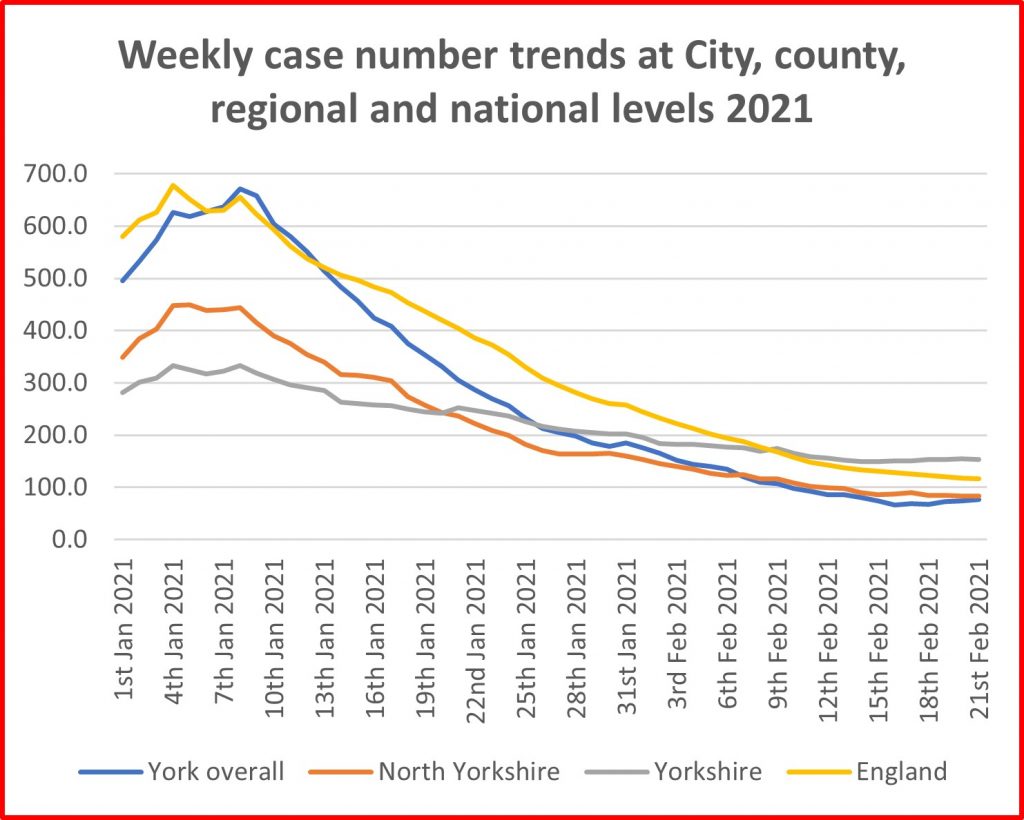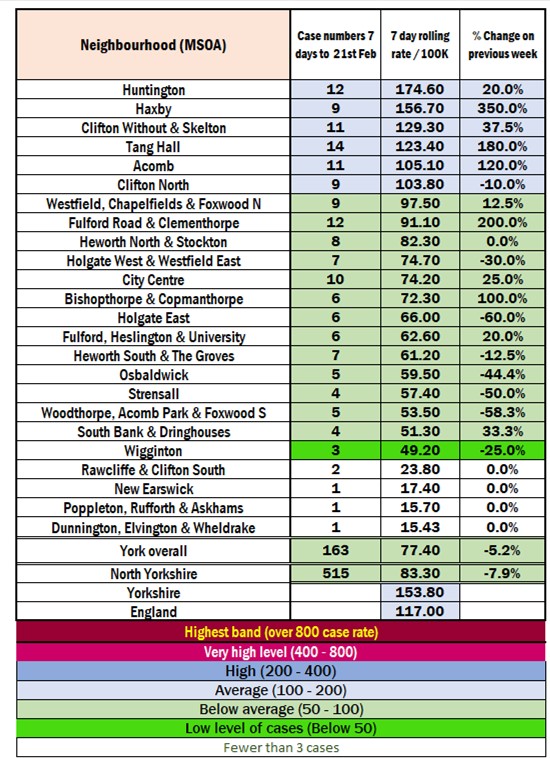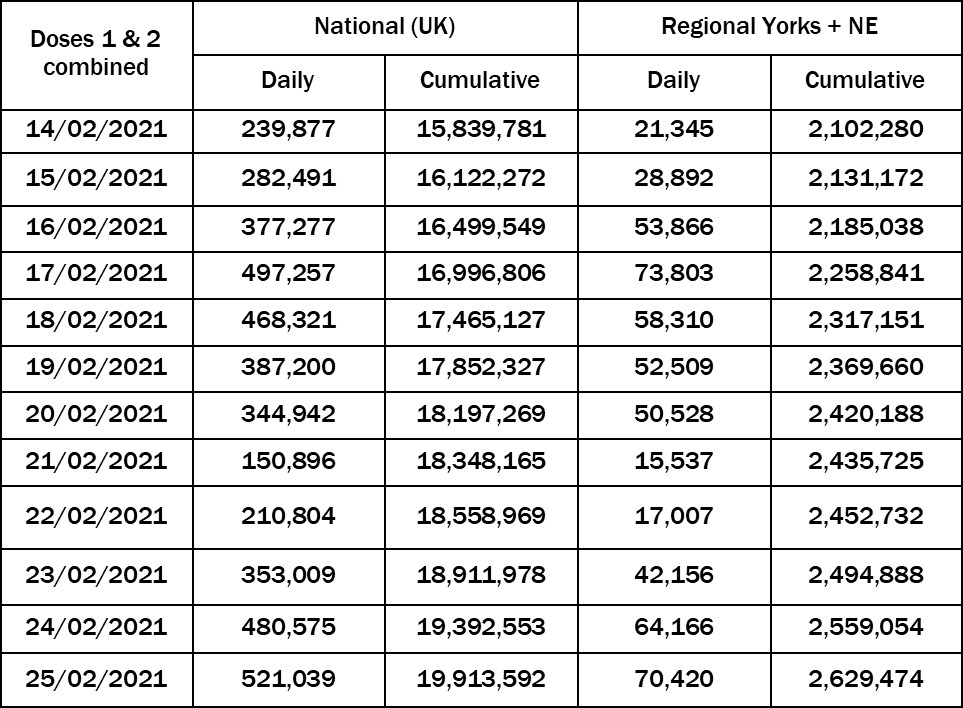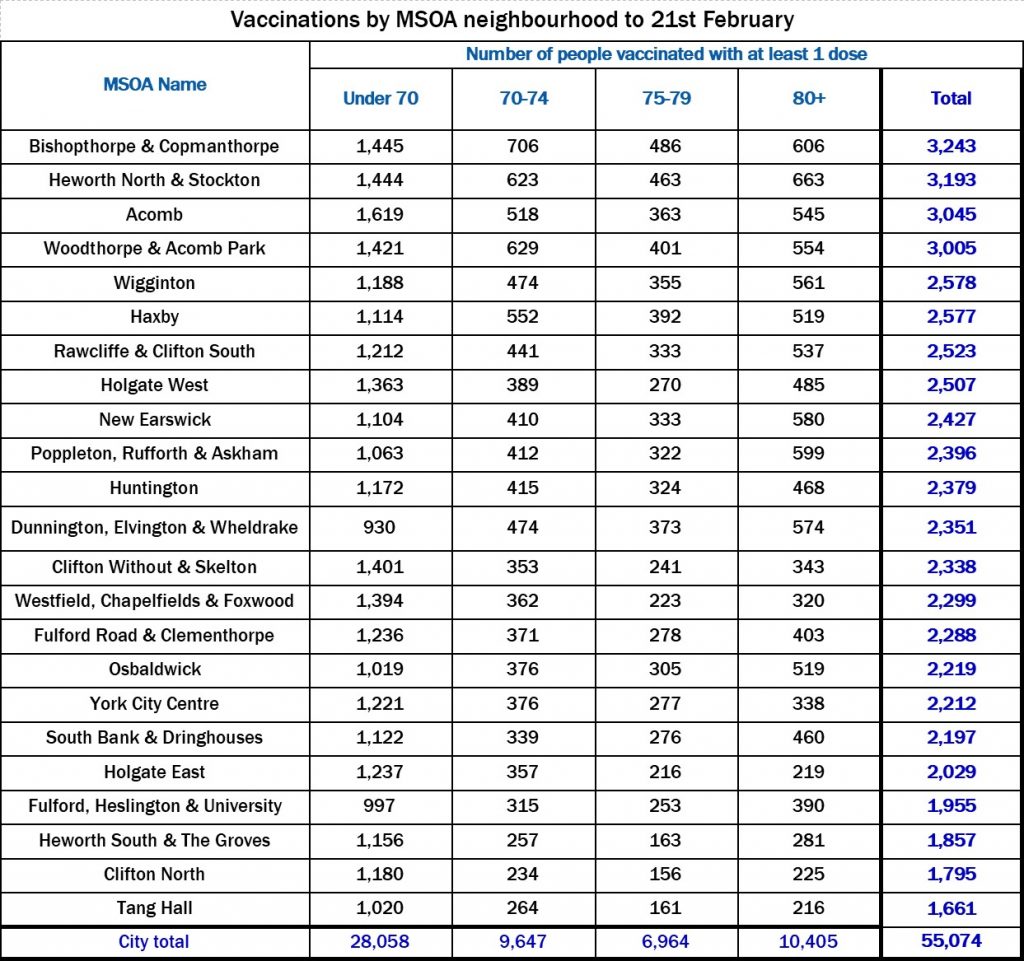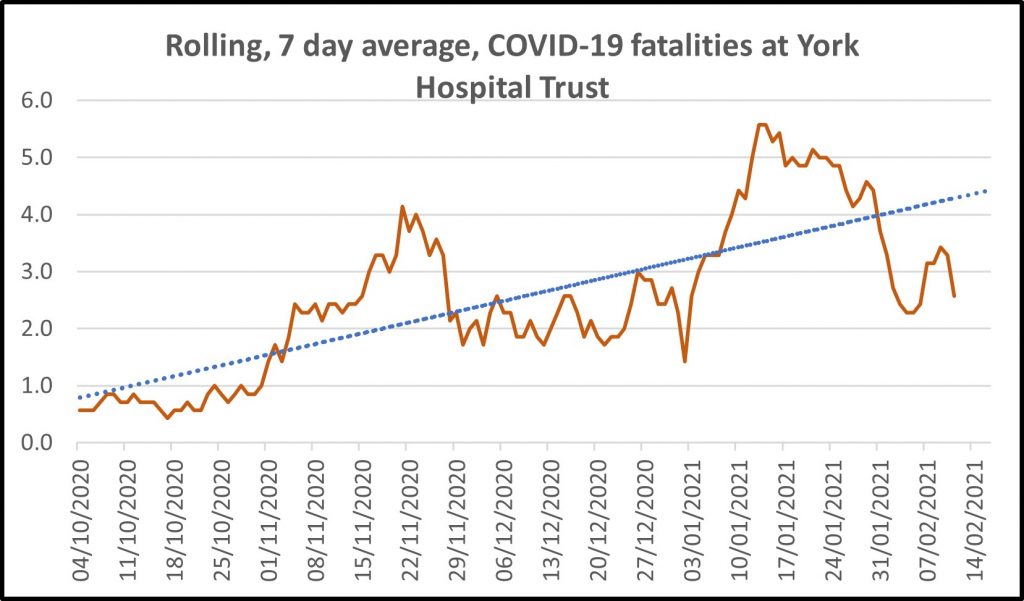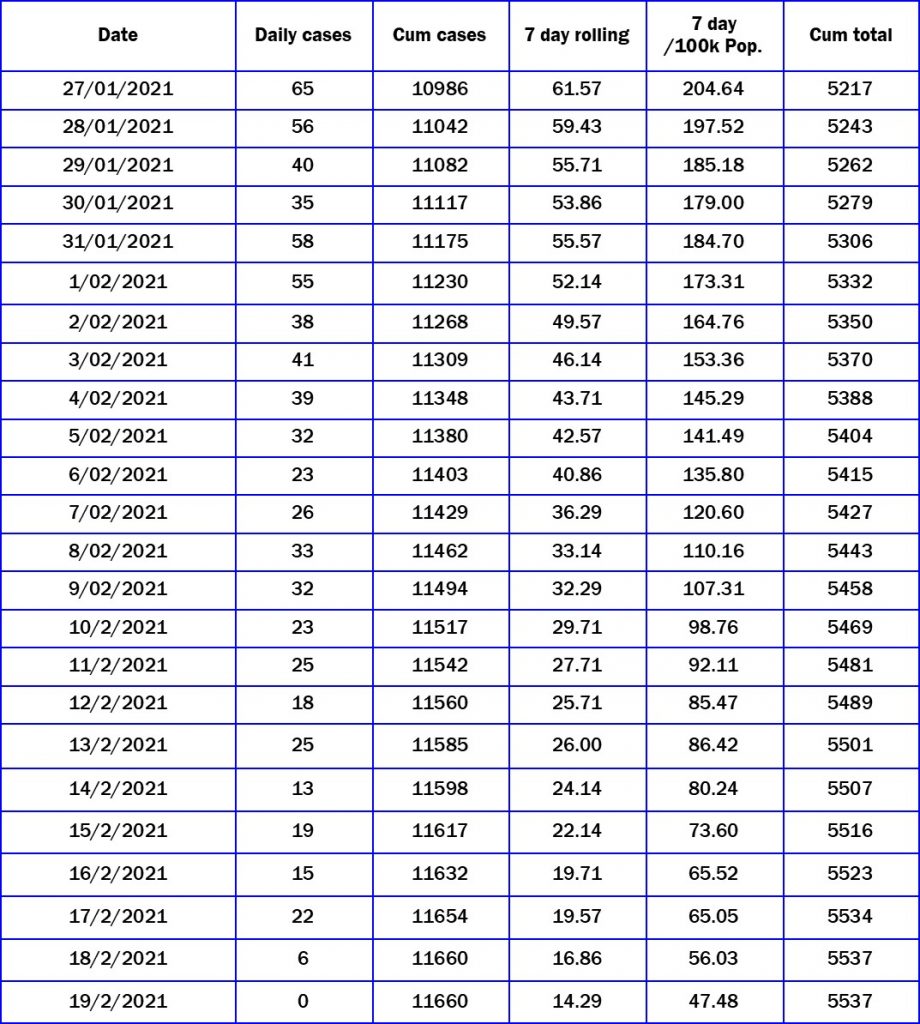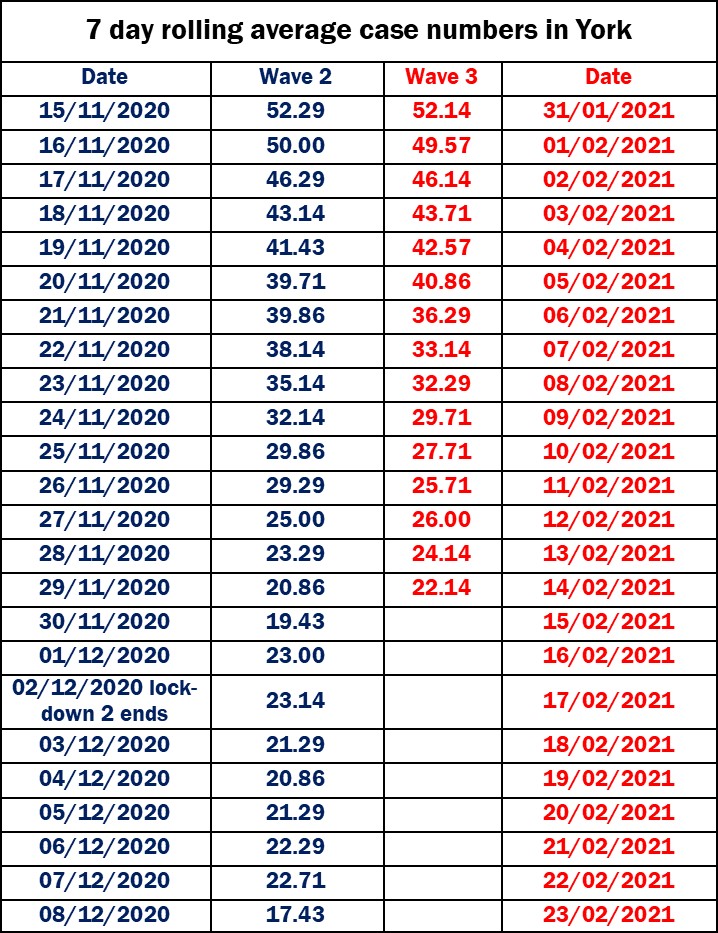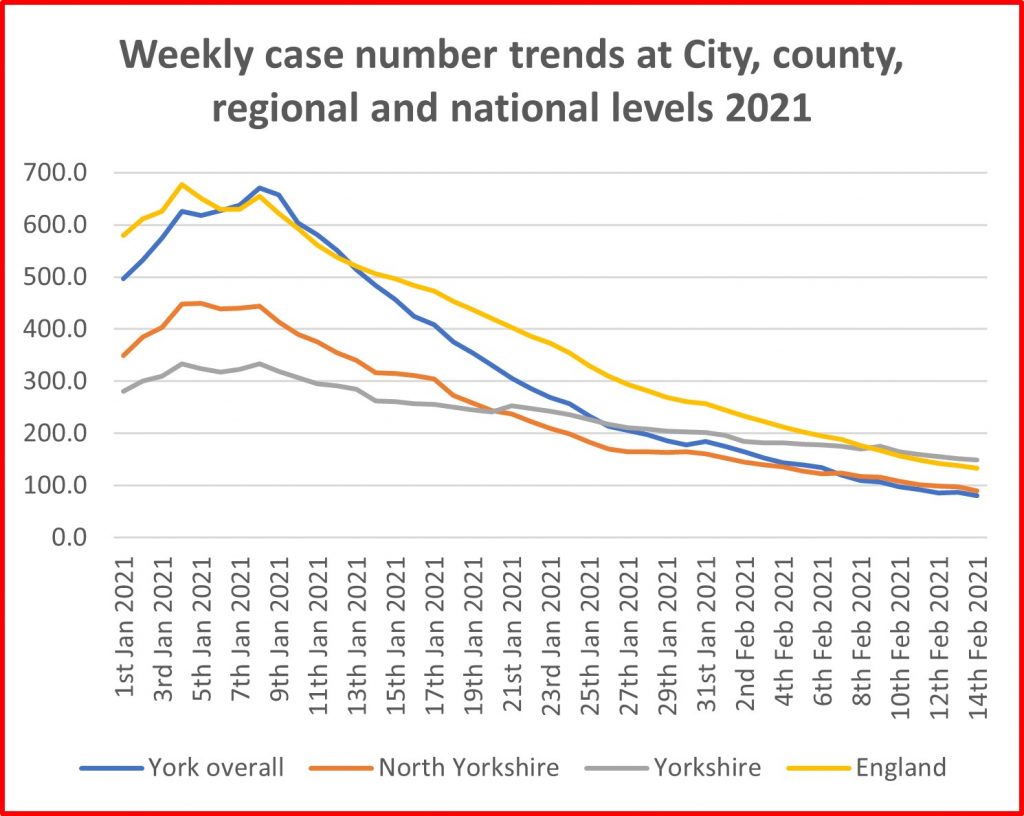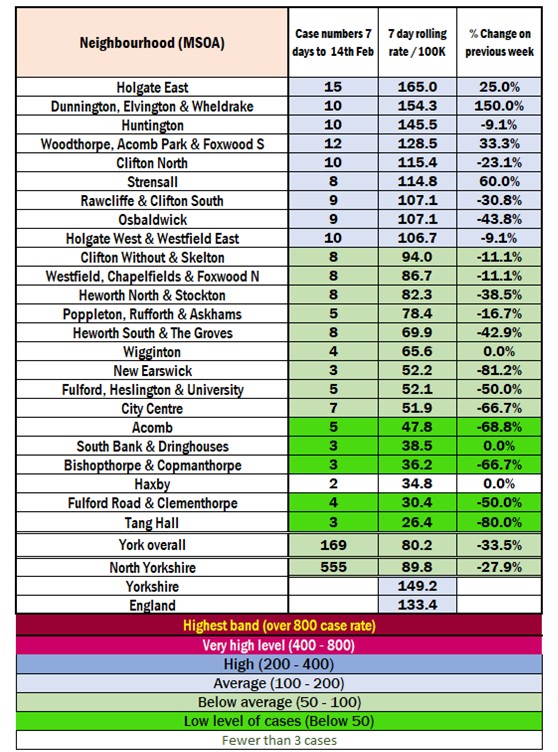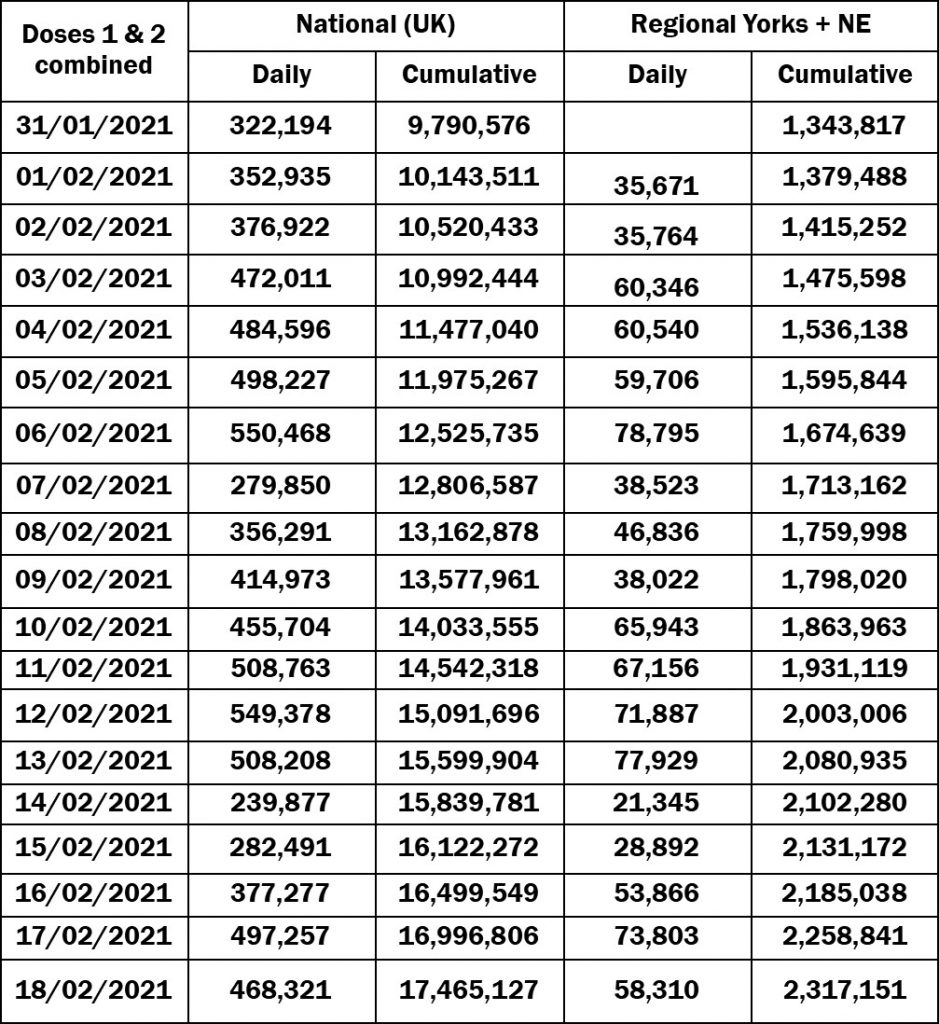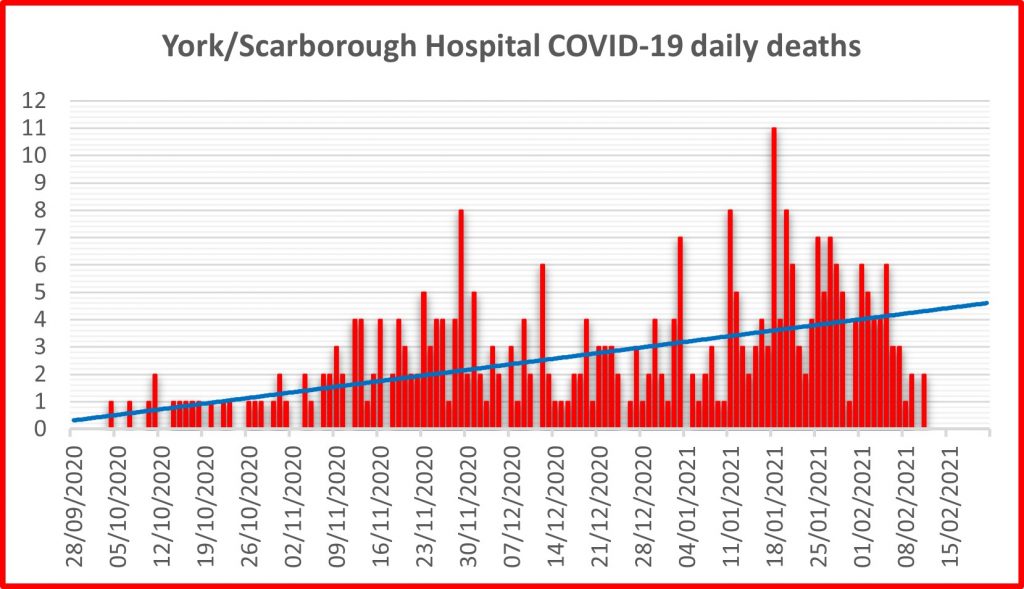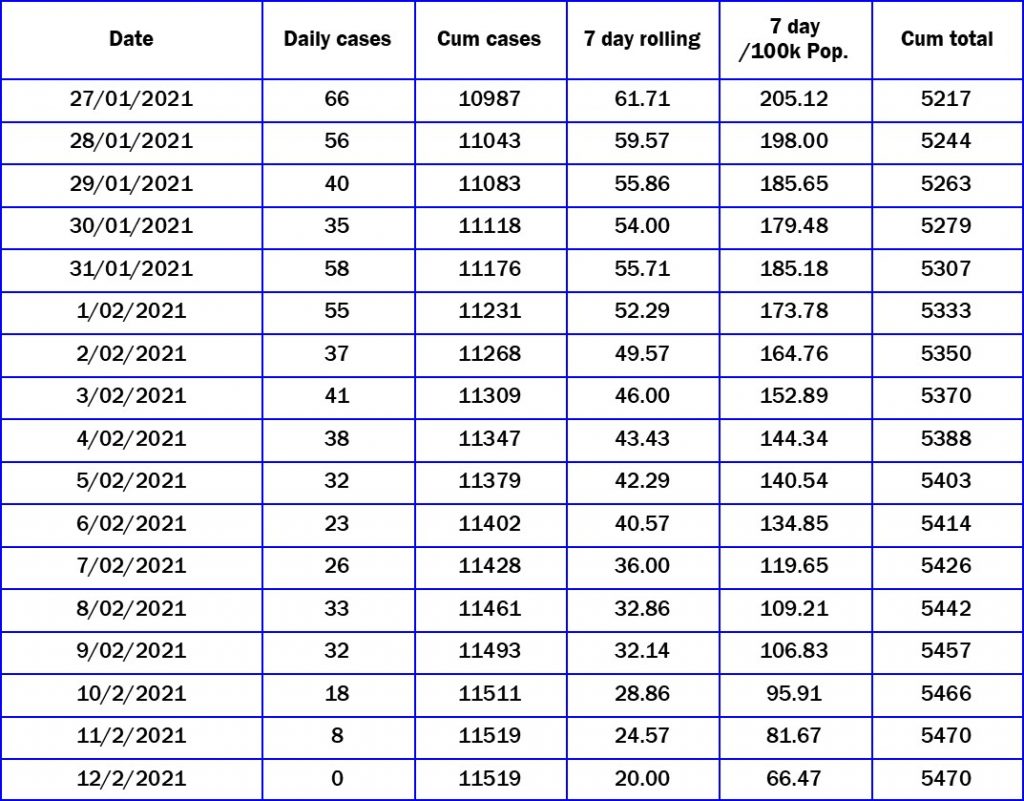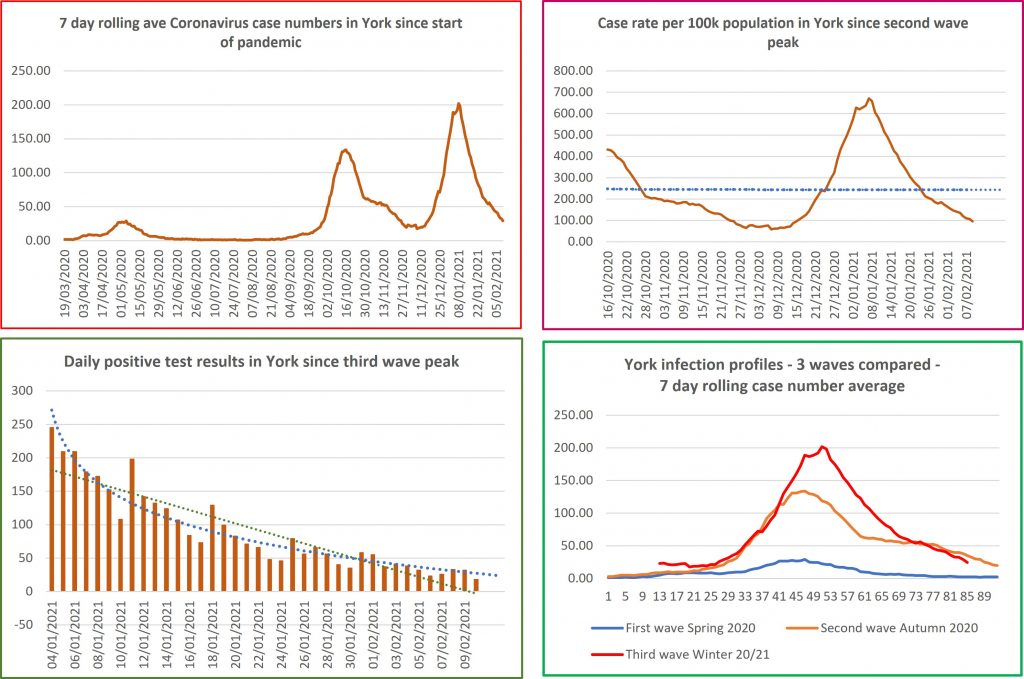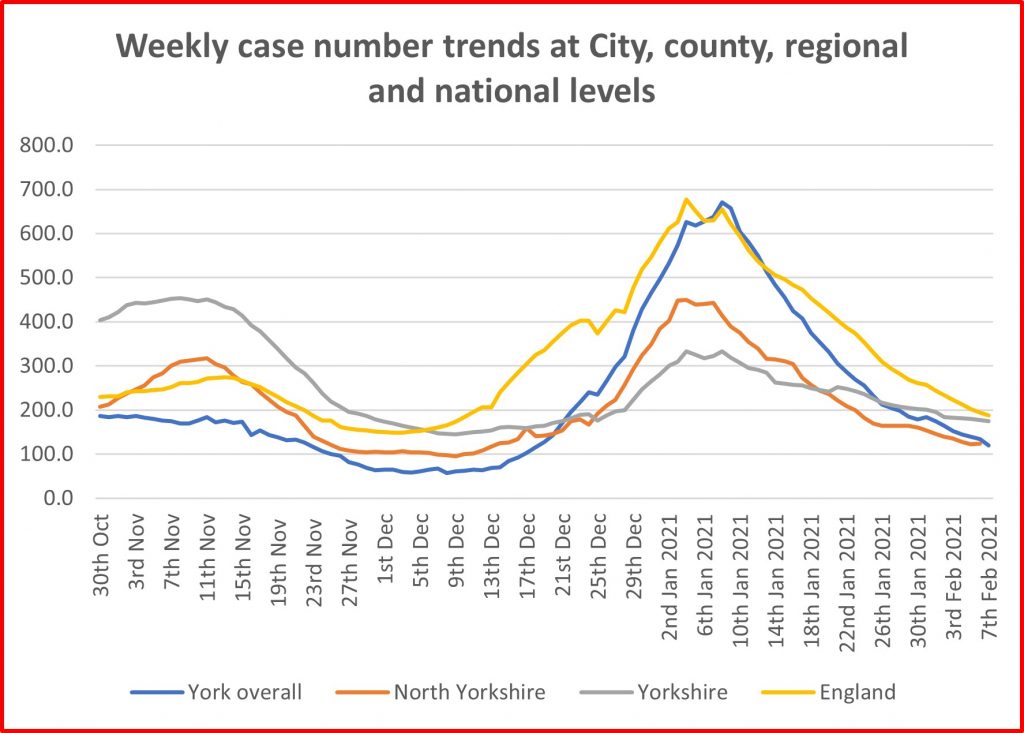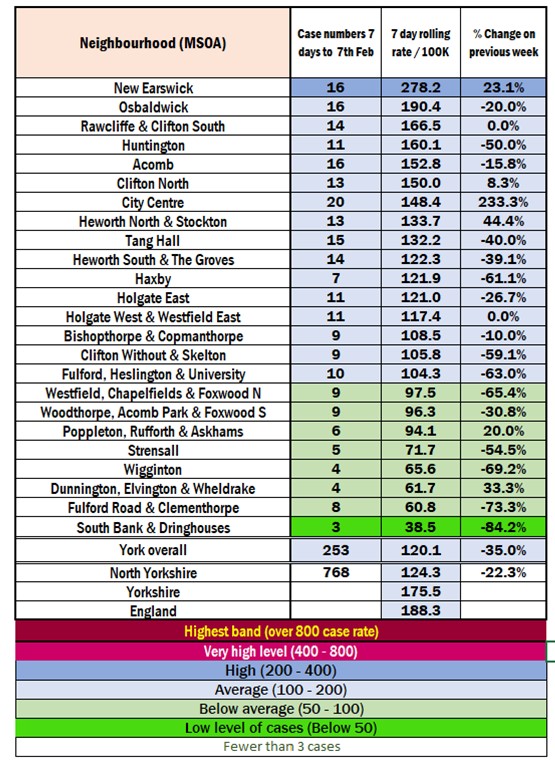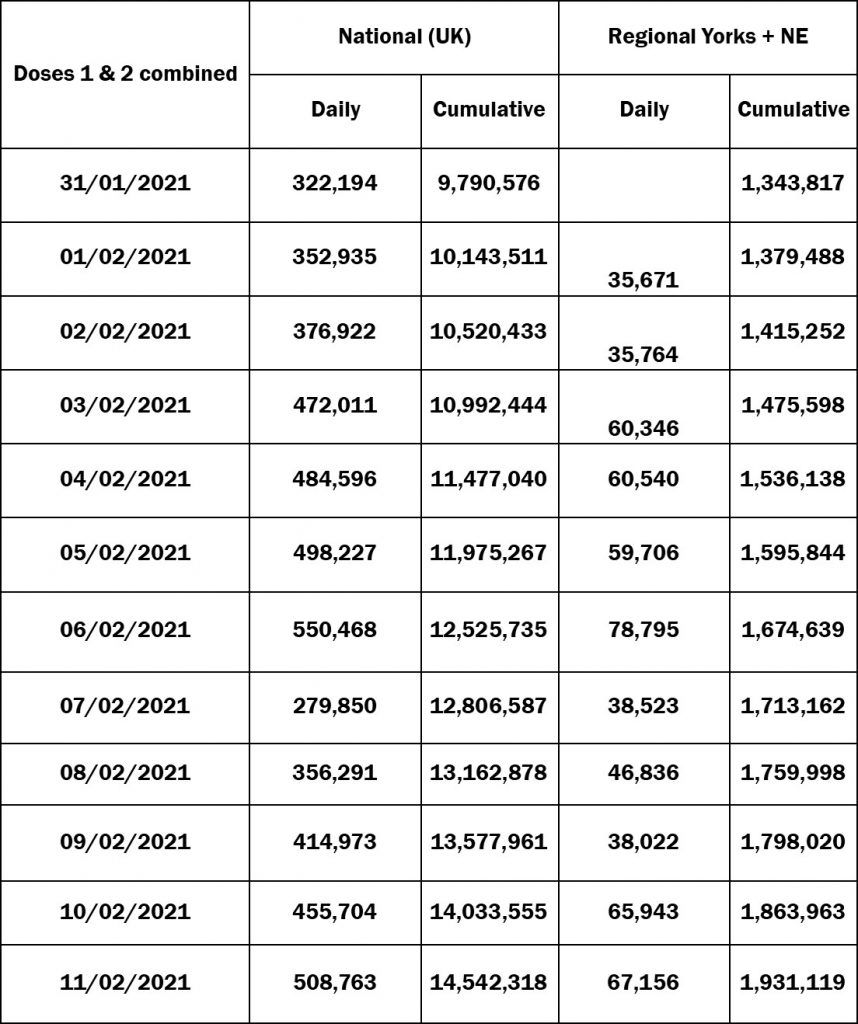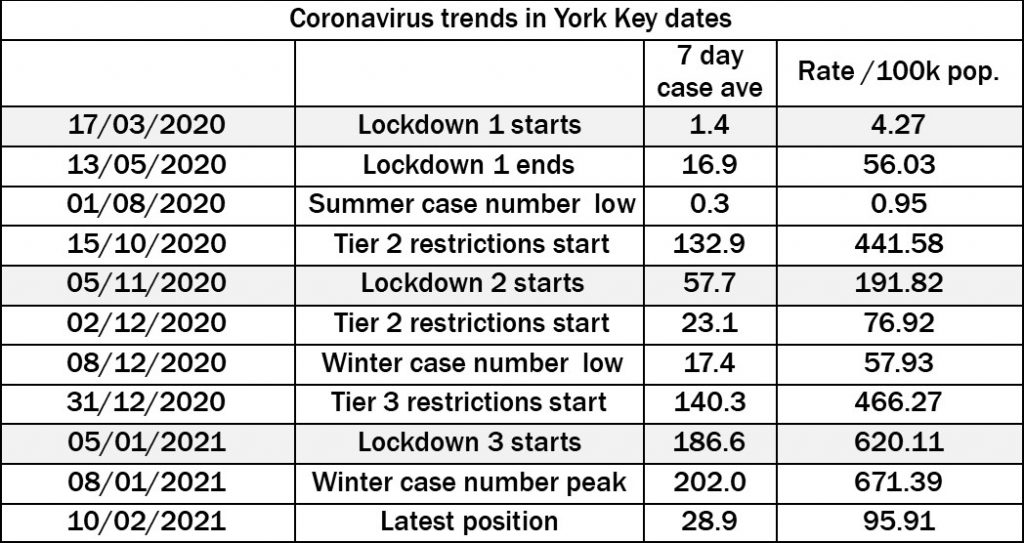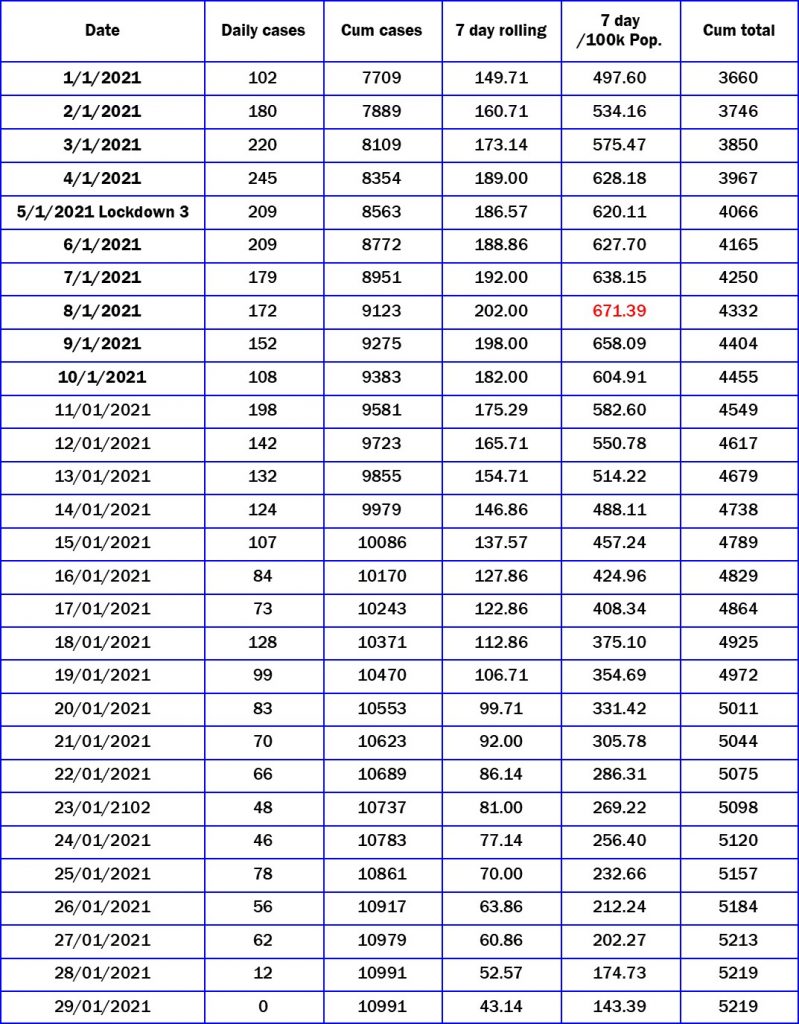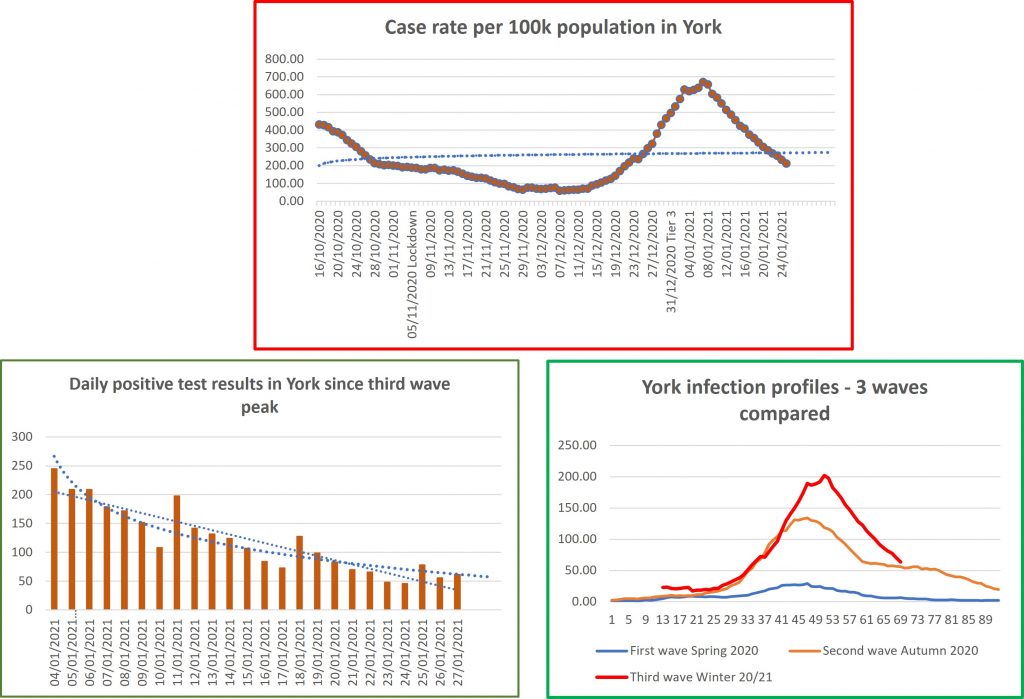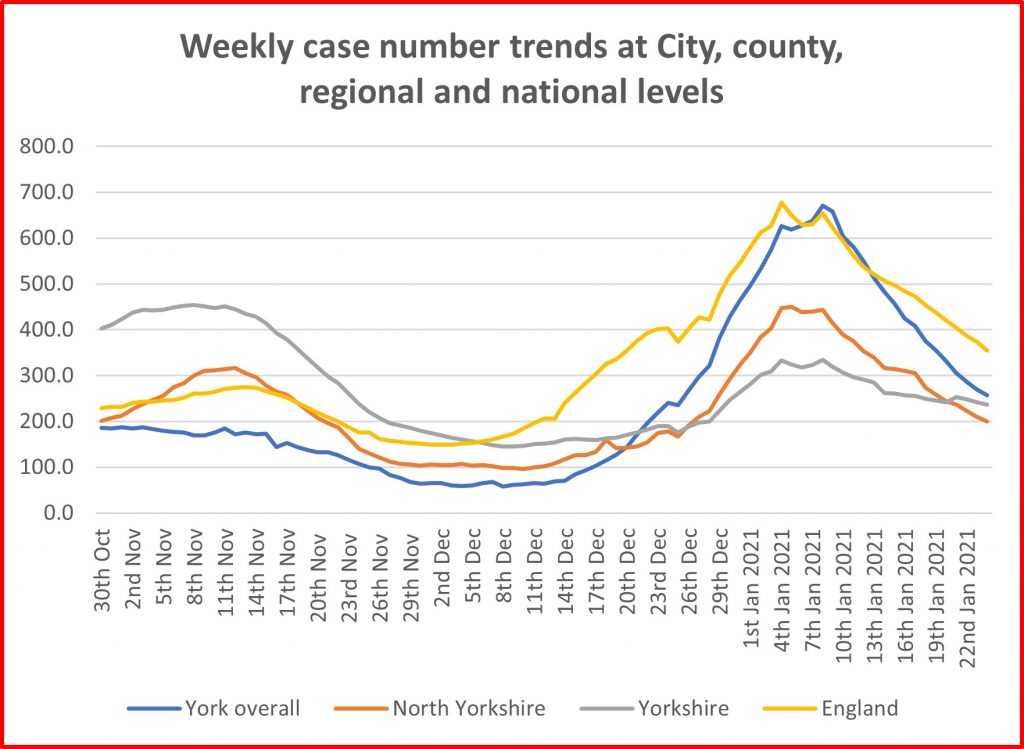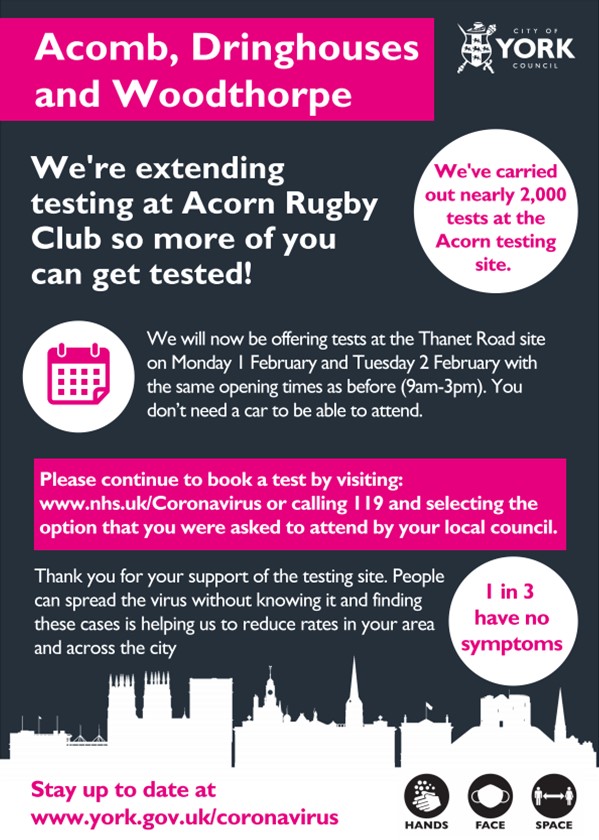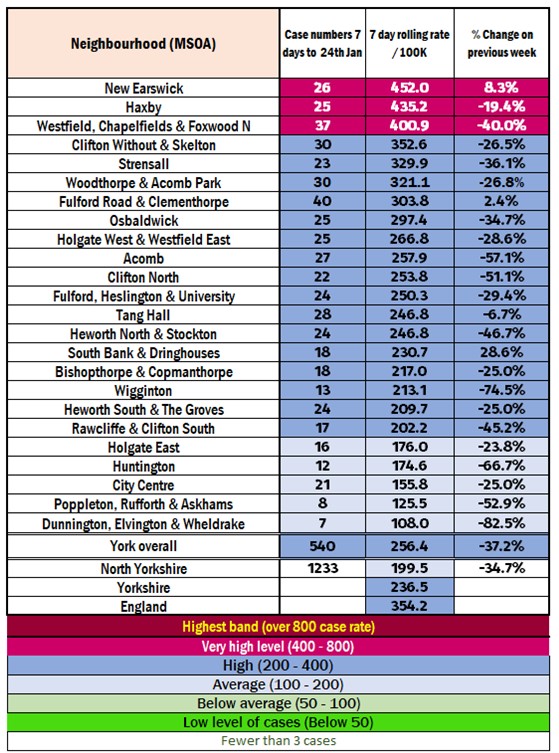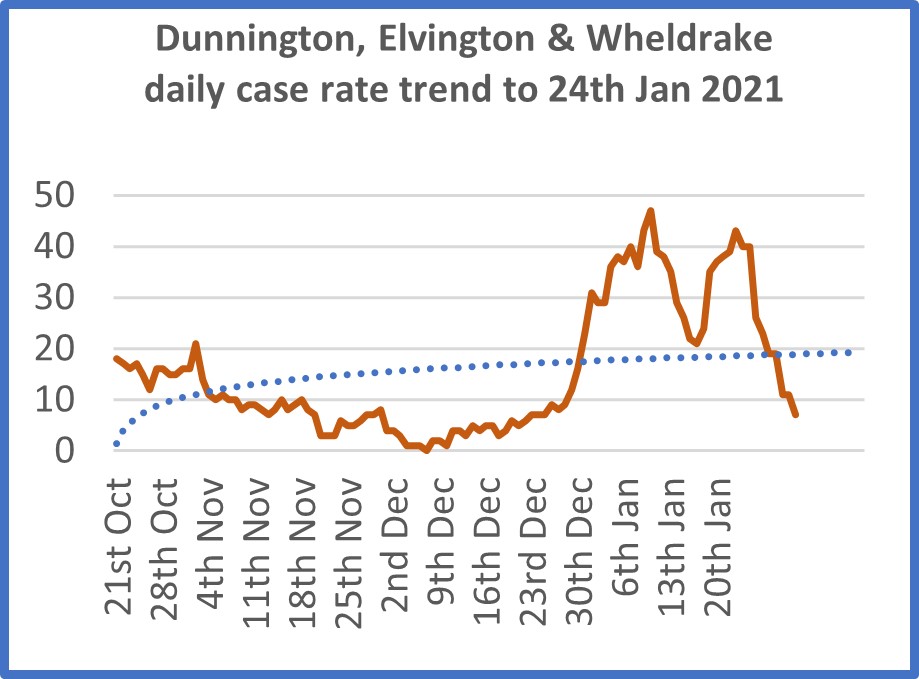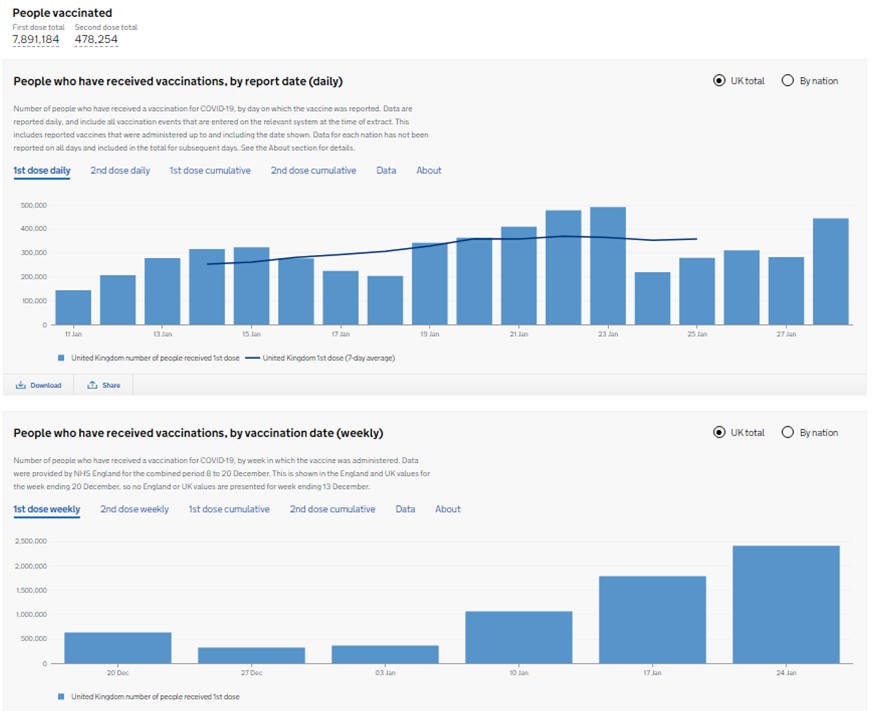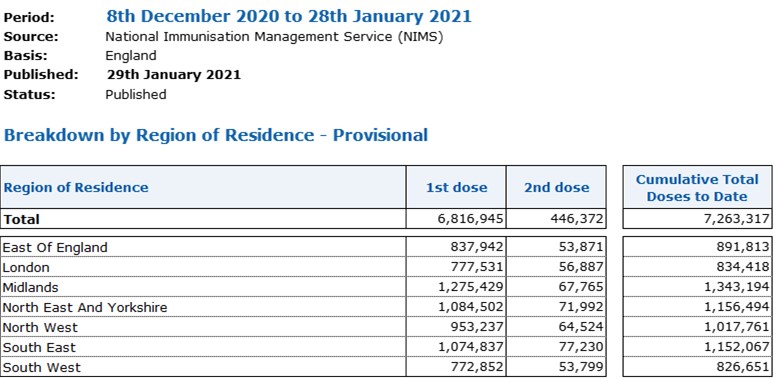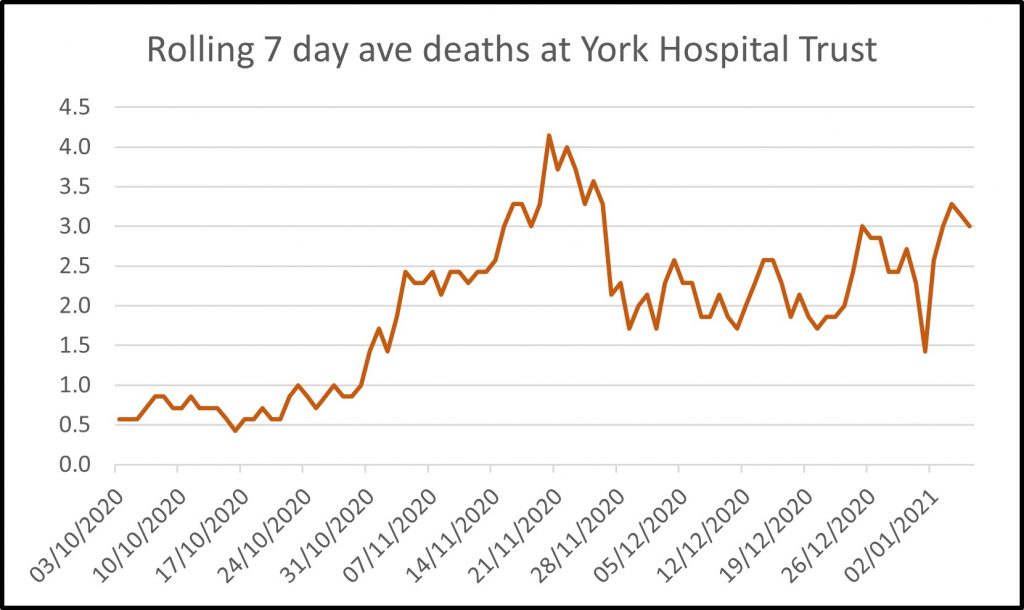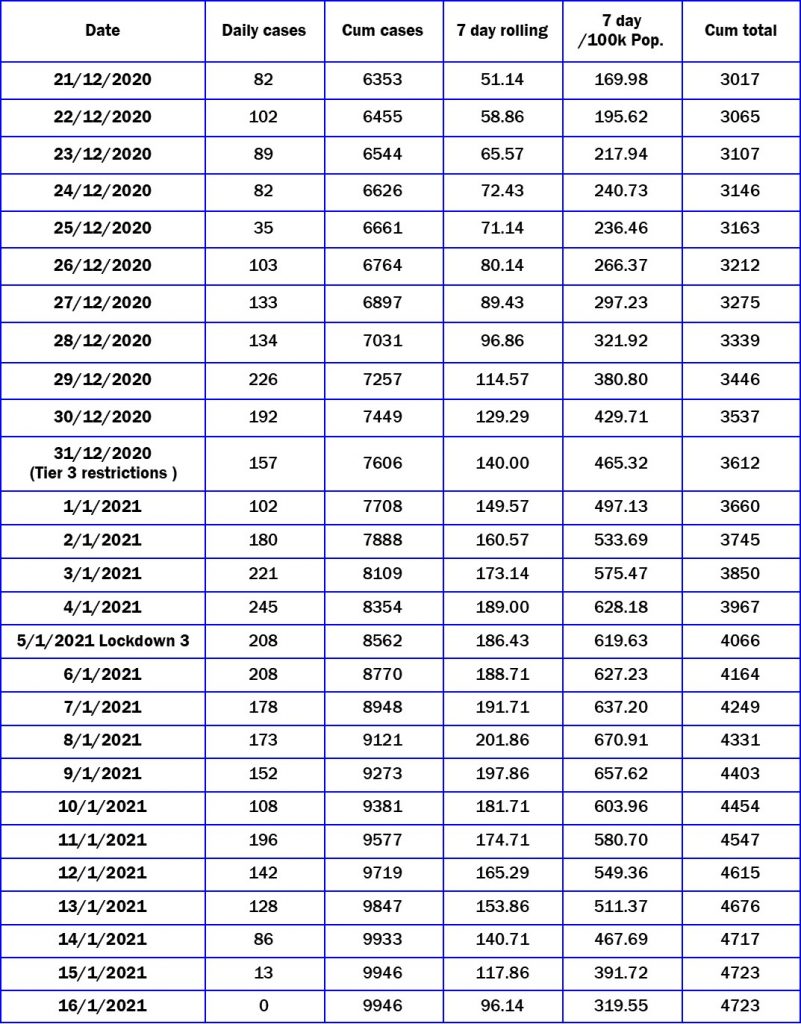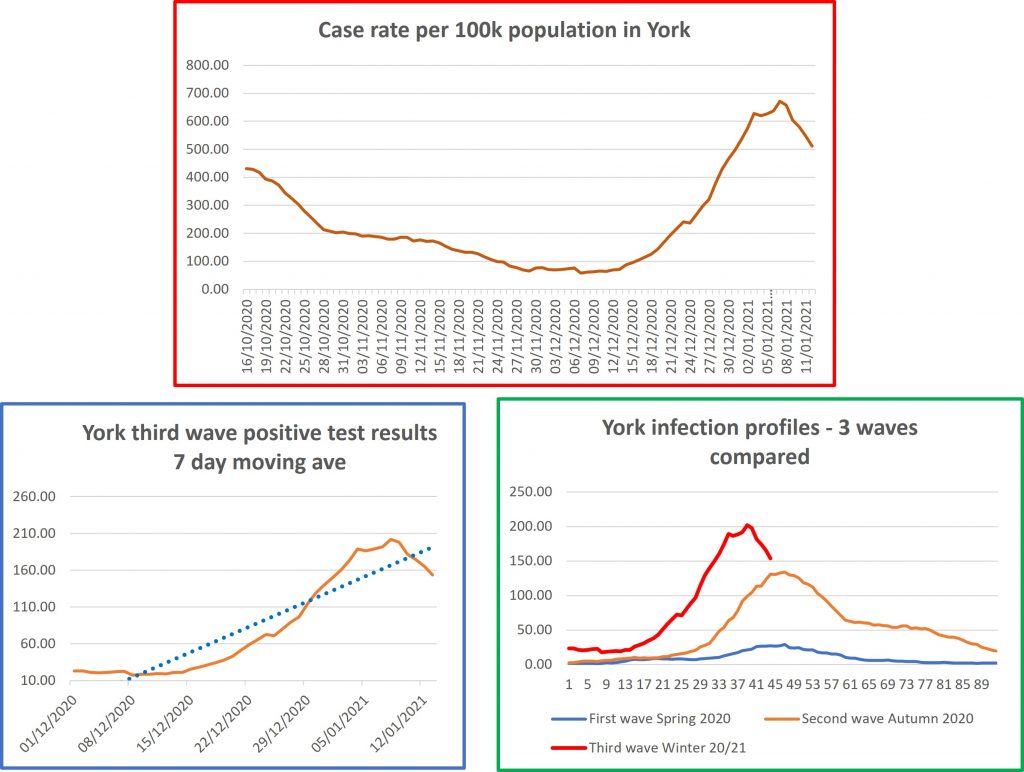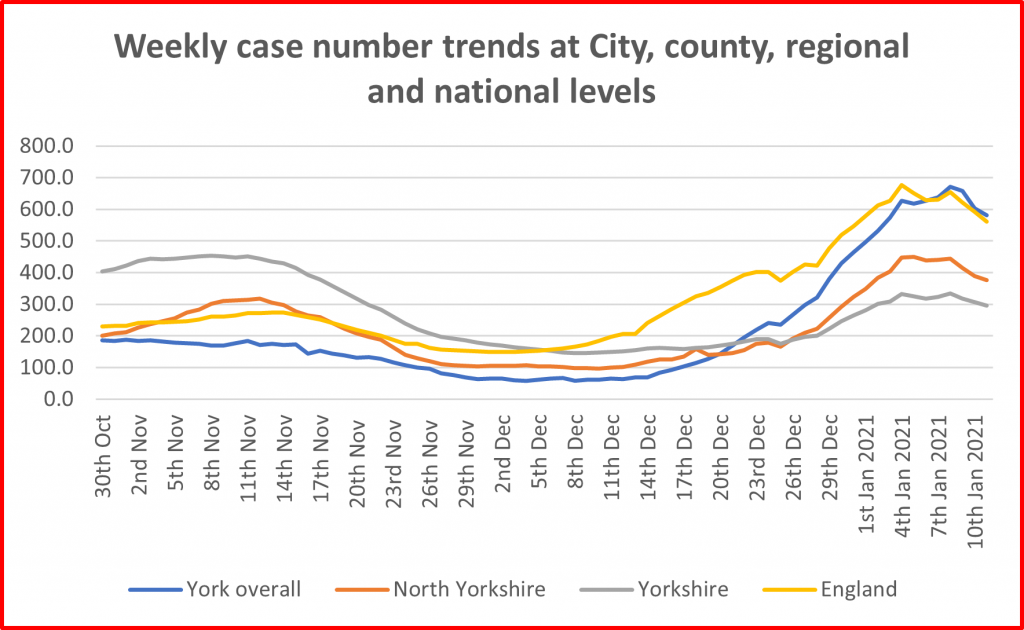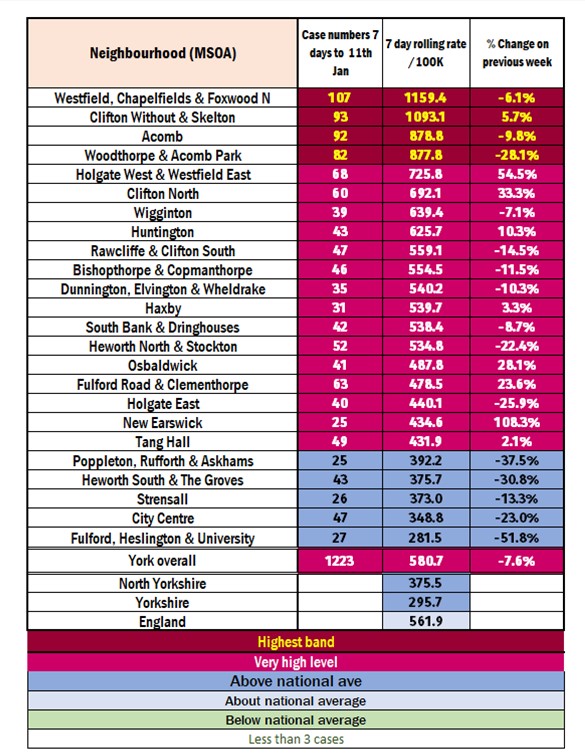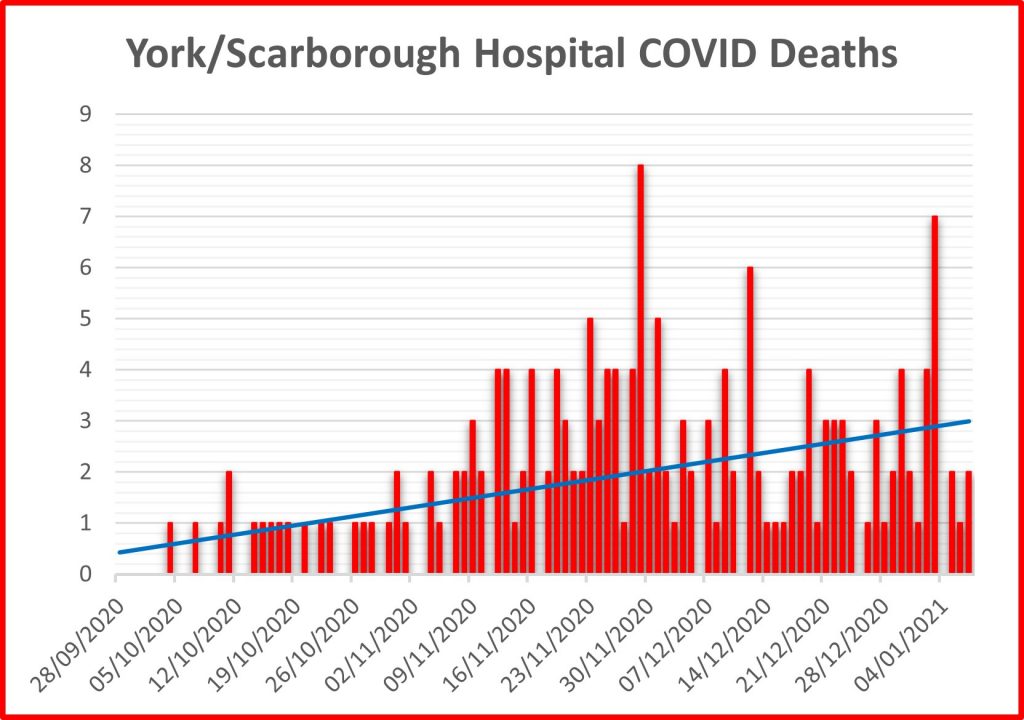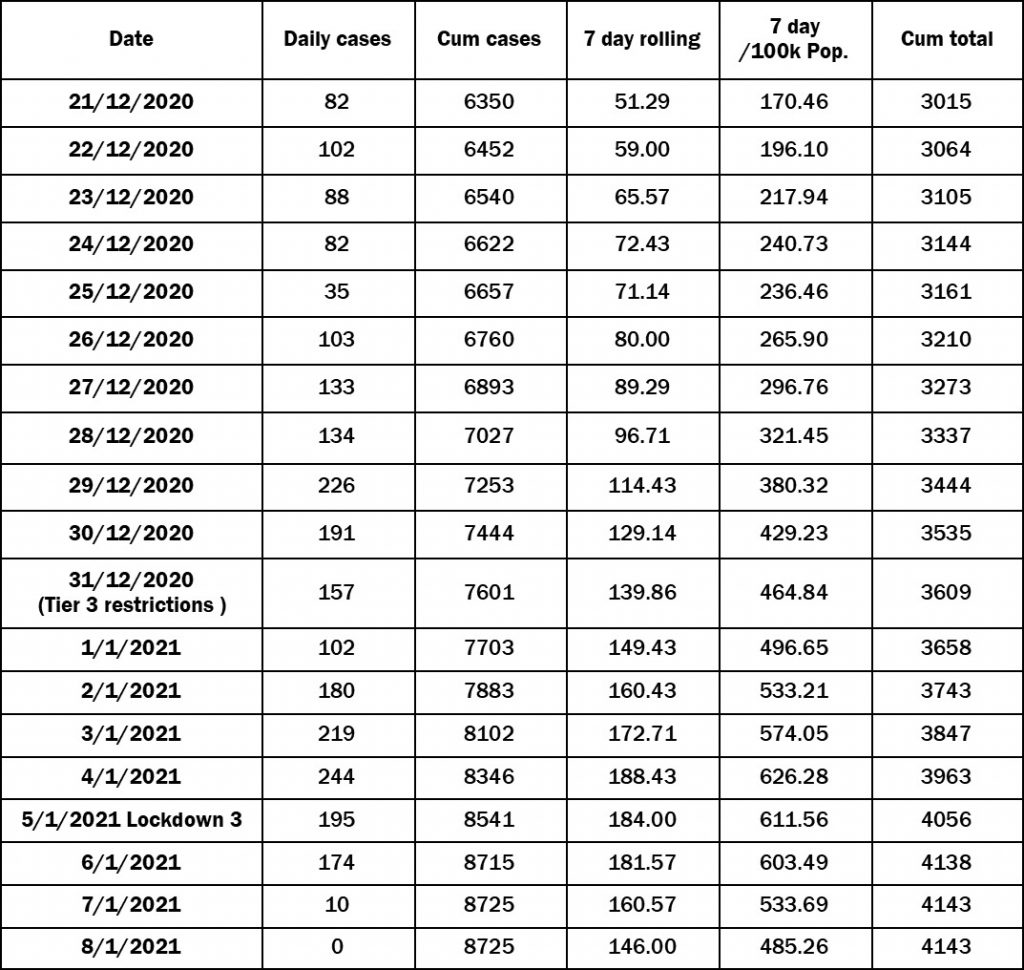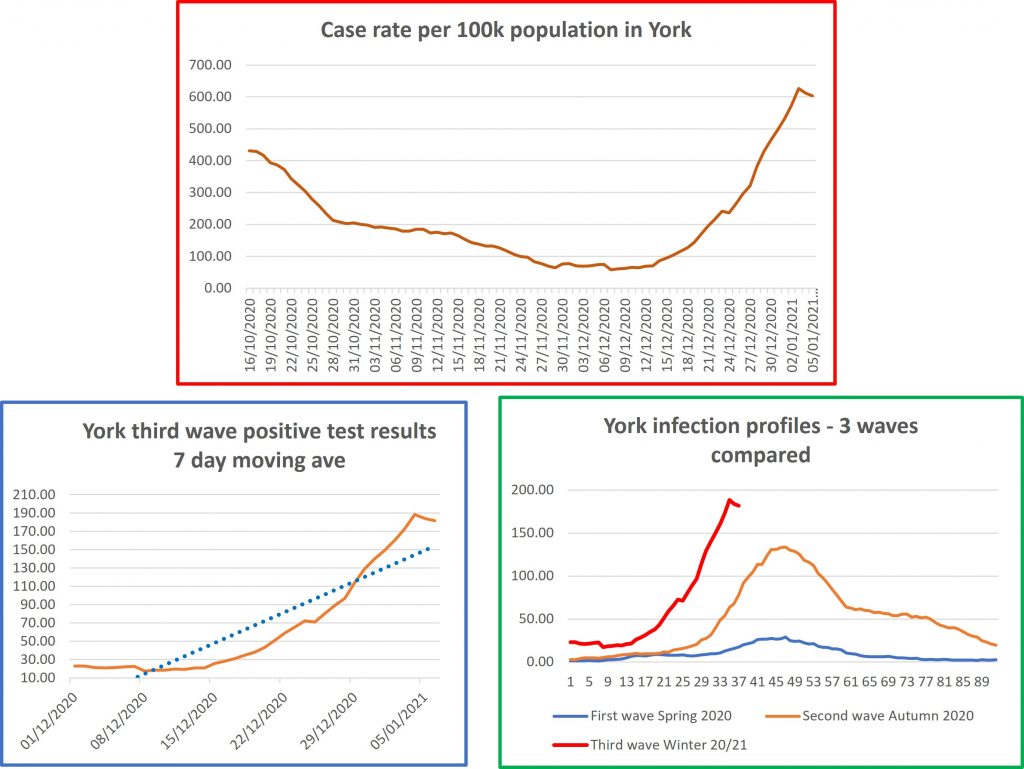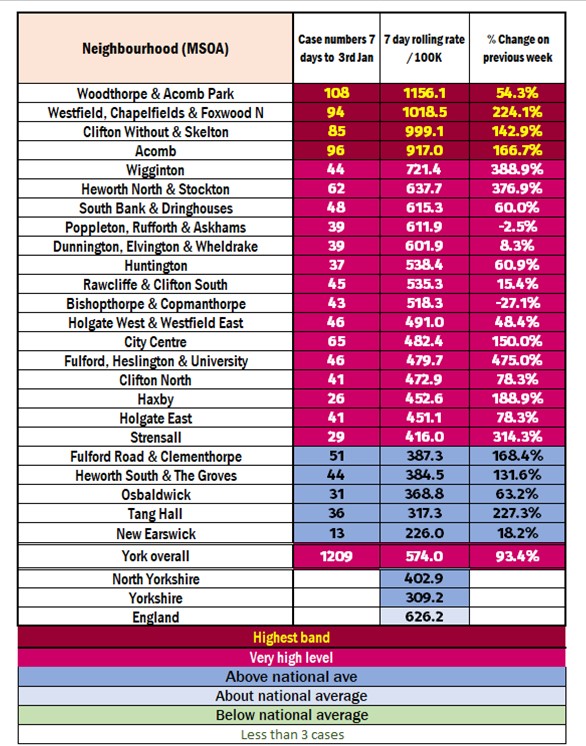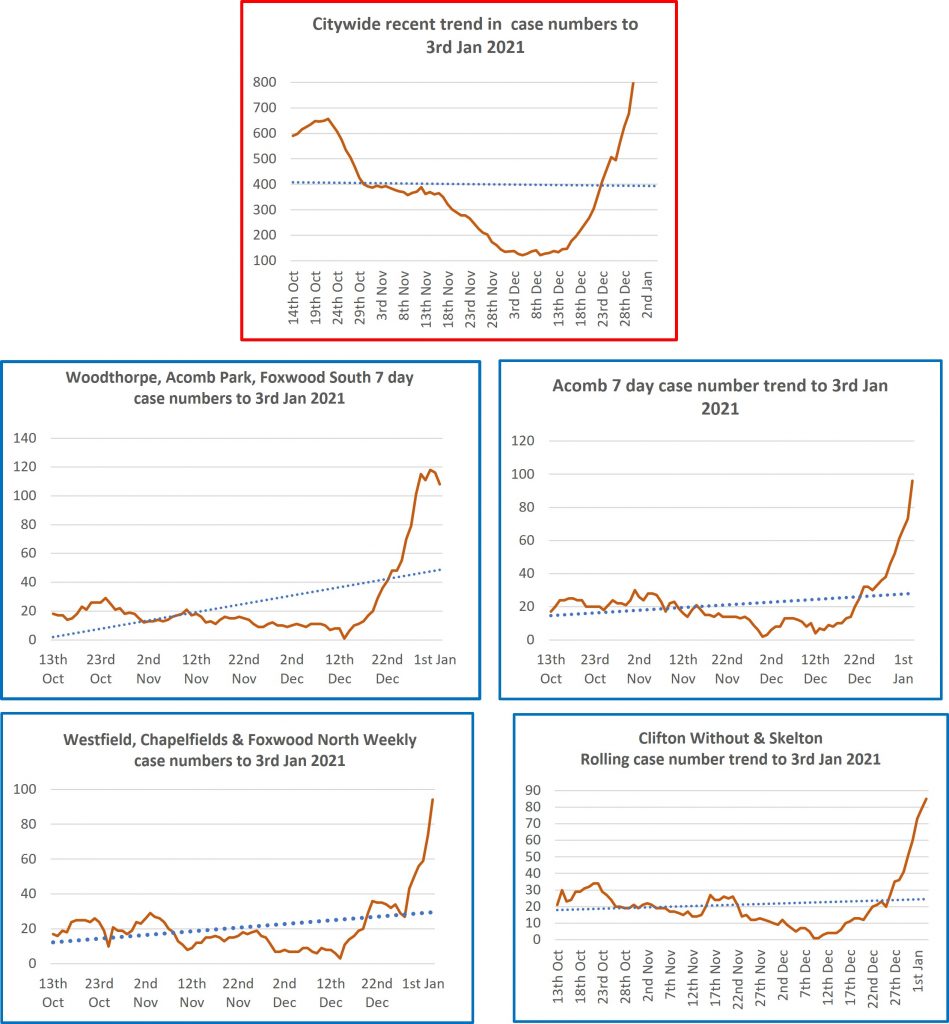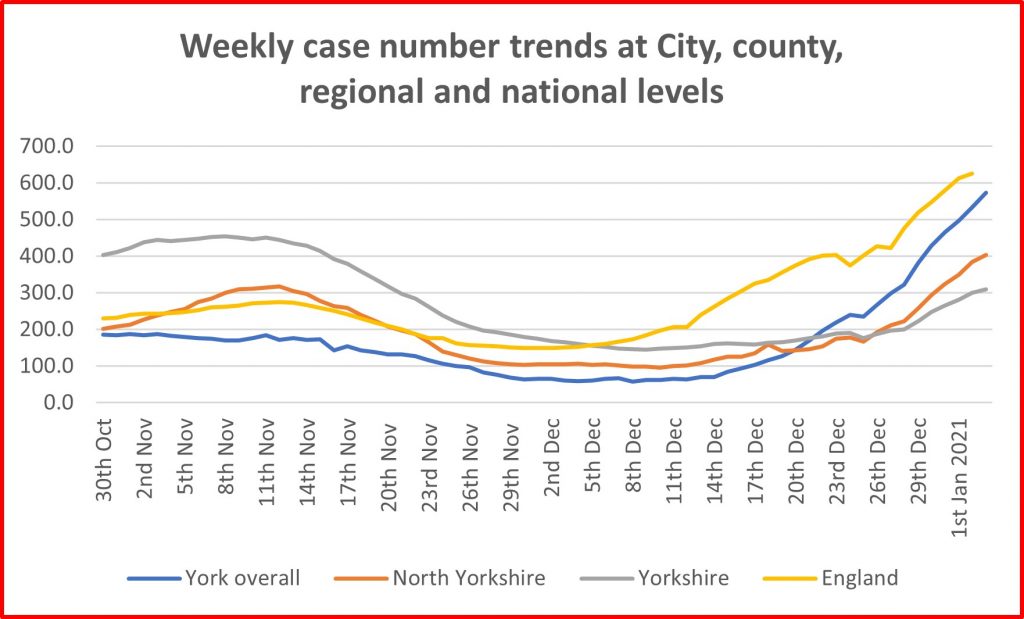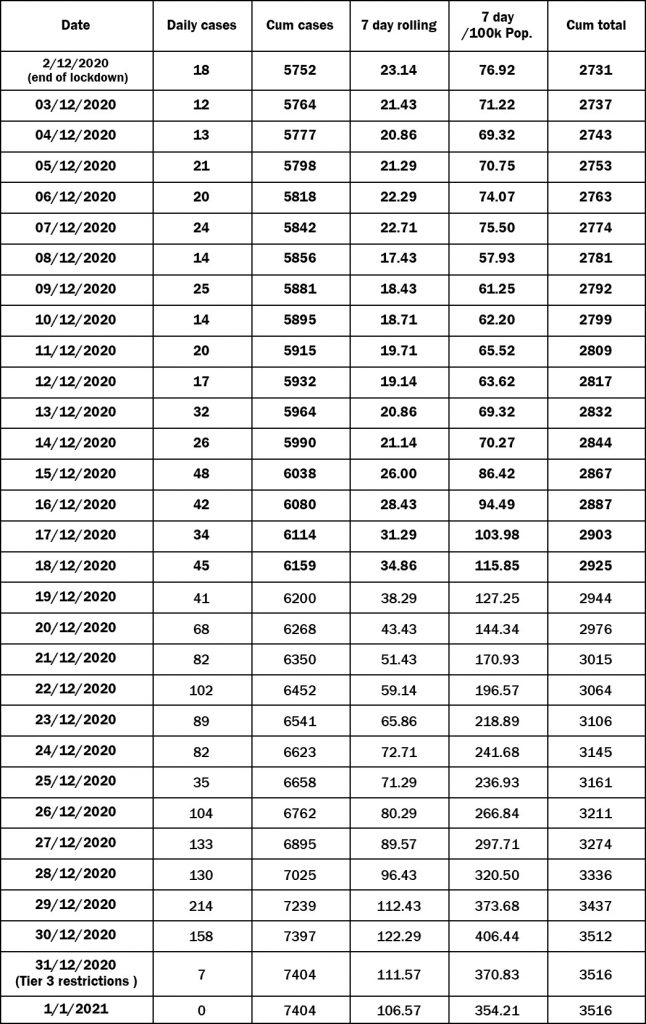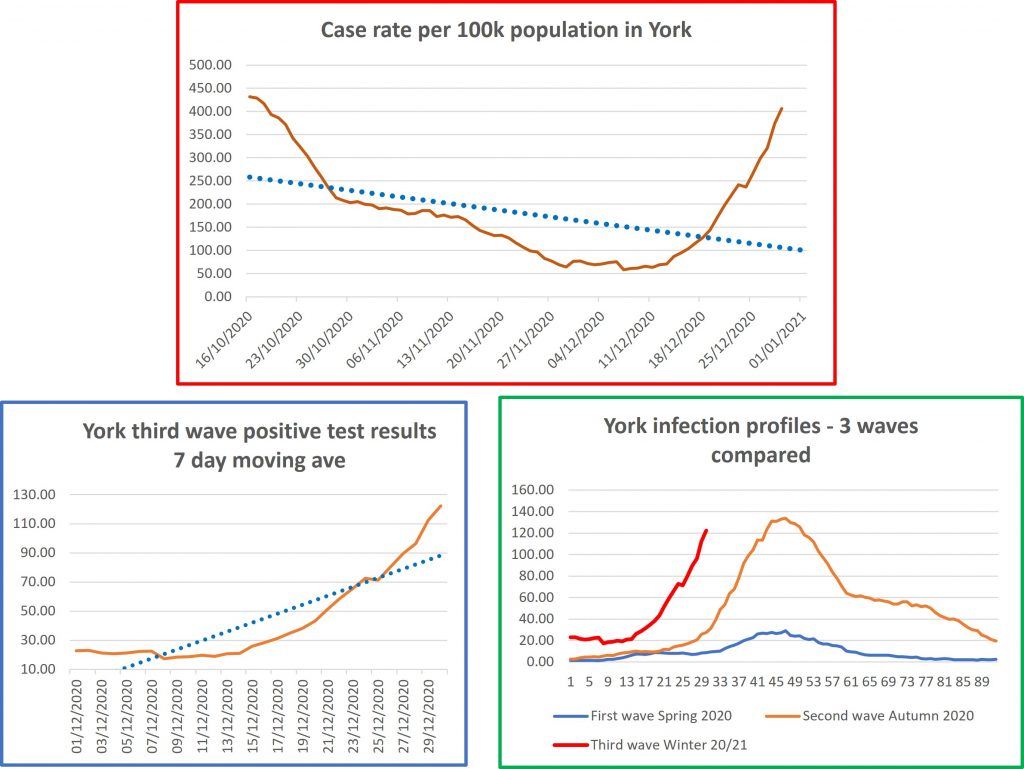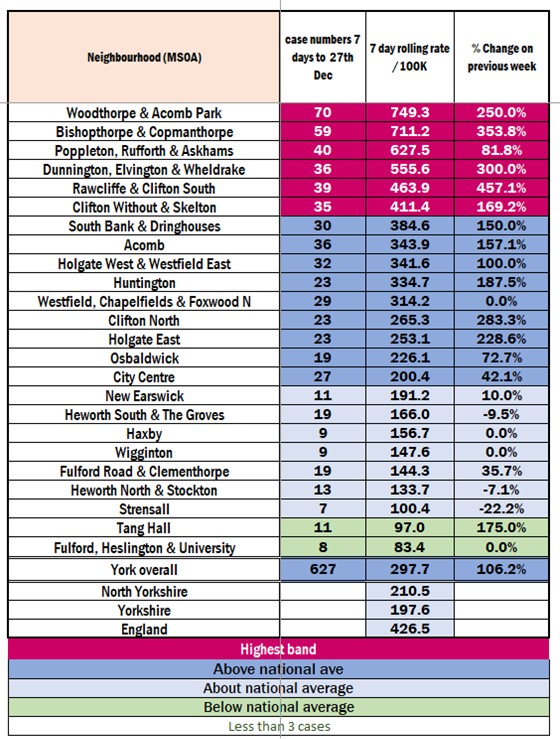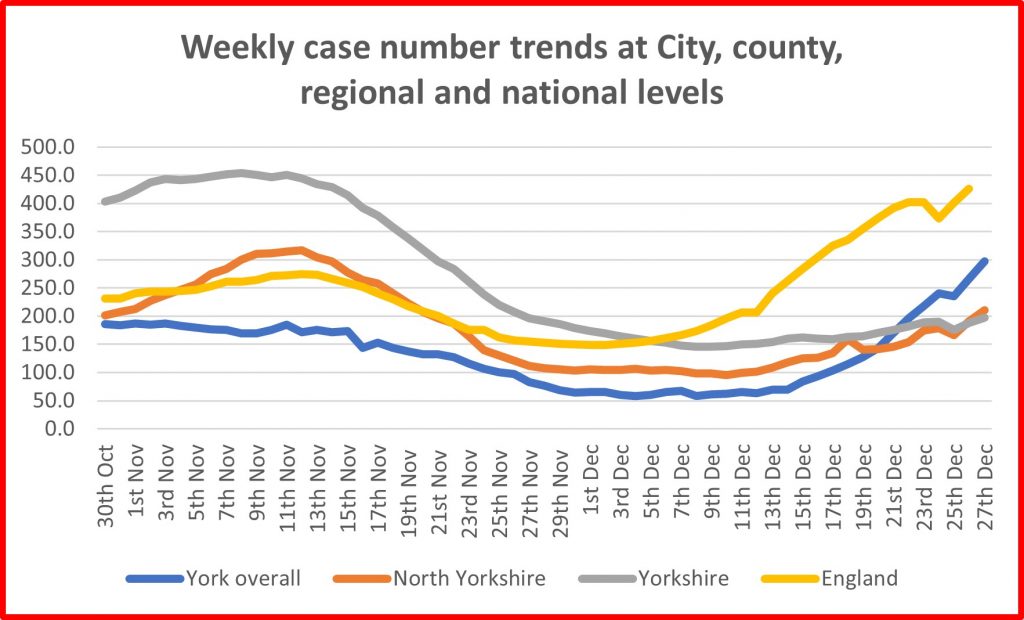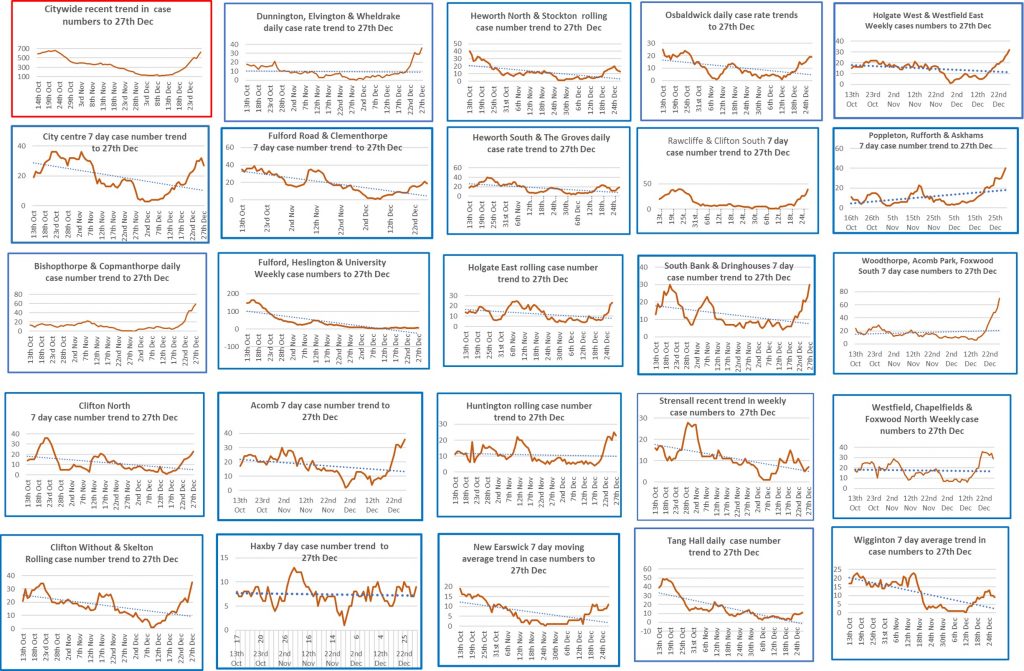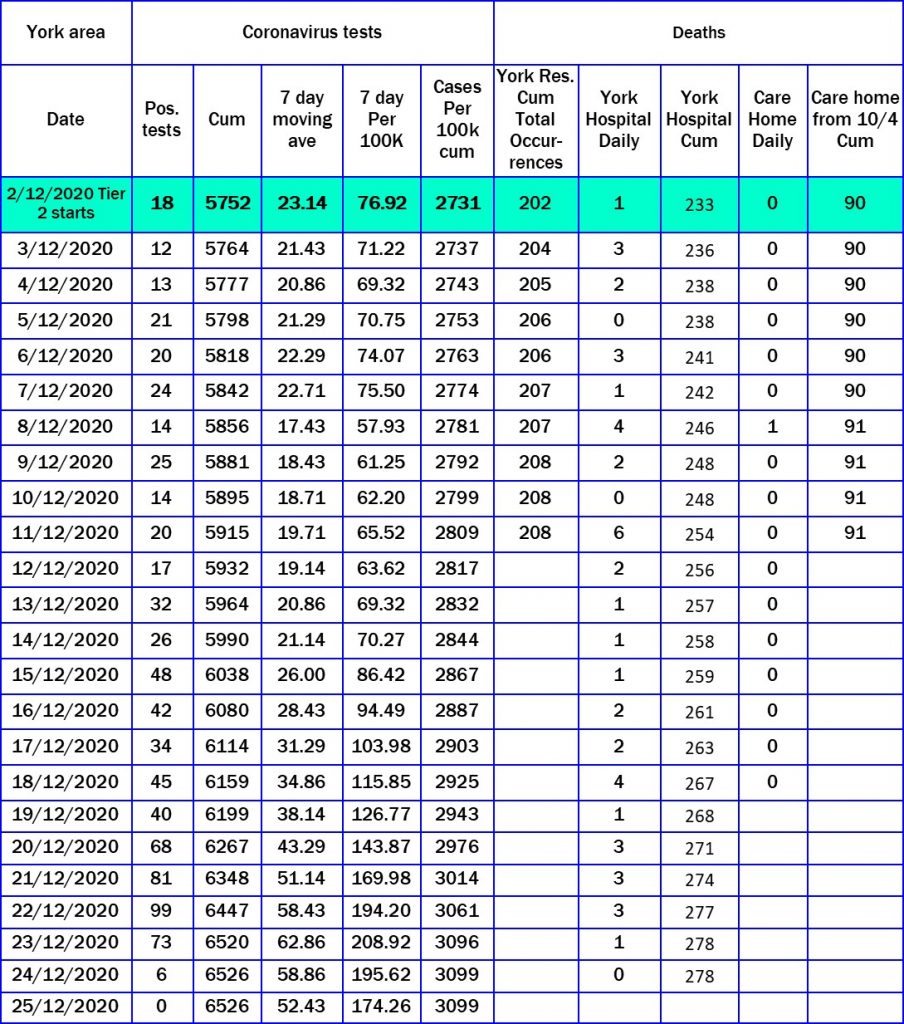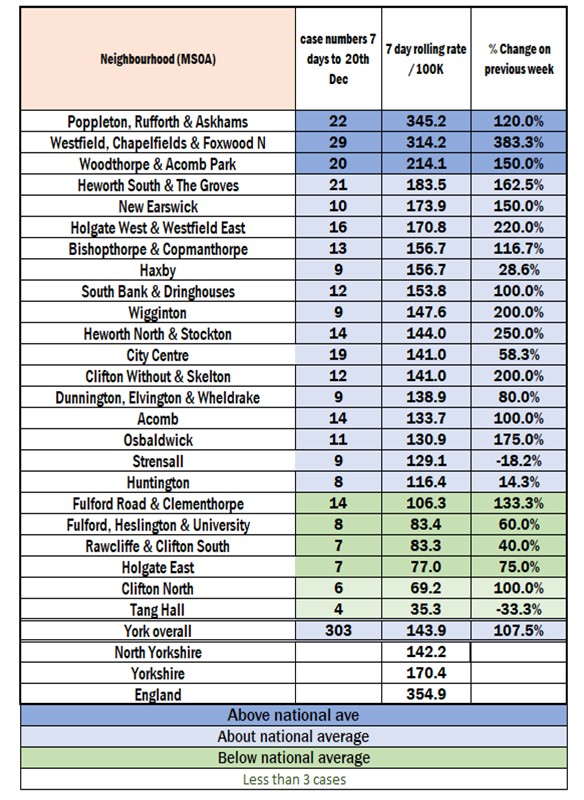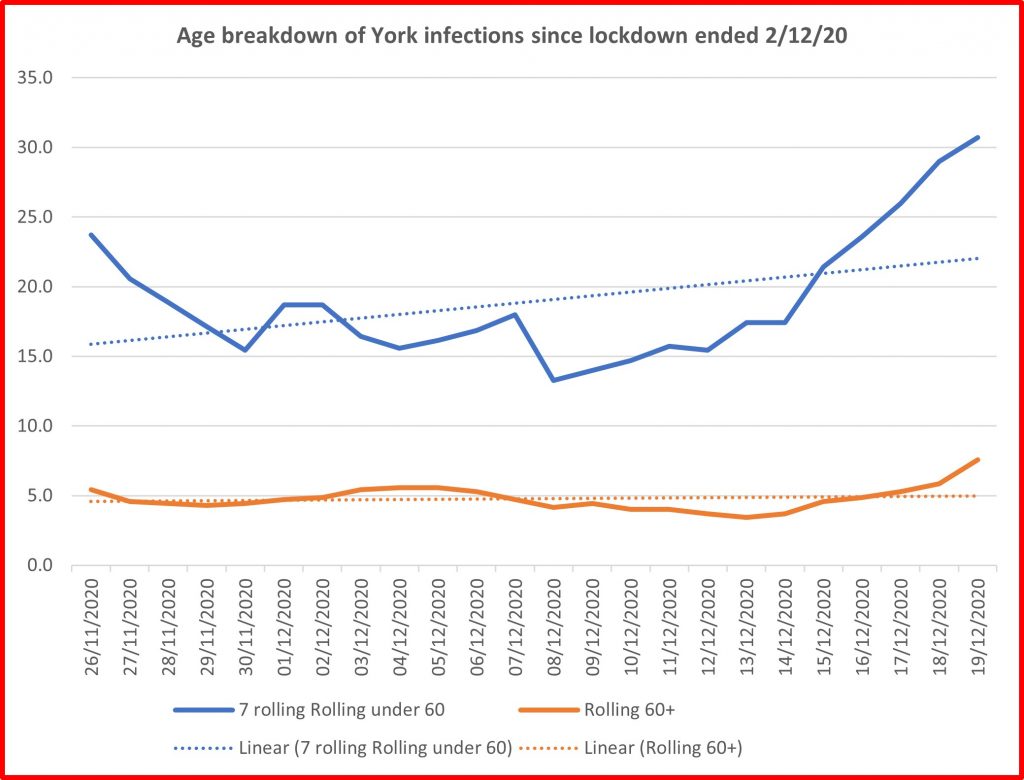Deaths
Two additional hospital deaths have been announced by the York Hospital Trust today. One occurred on Tuesday and one on Wednesday
Test Results
Five positive test results today bringing the cumulative total to 12,099.
The number of cases in the City has fallen by 8 from 89 to 81. Further reductions are in the pipeline
The rate /100k population figure has fallen to 38.46. This is the lowest seen in the City since 19th September 2021
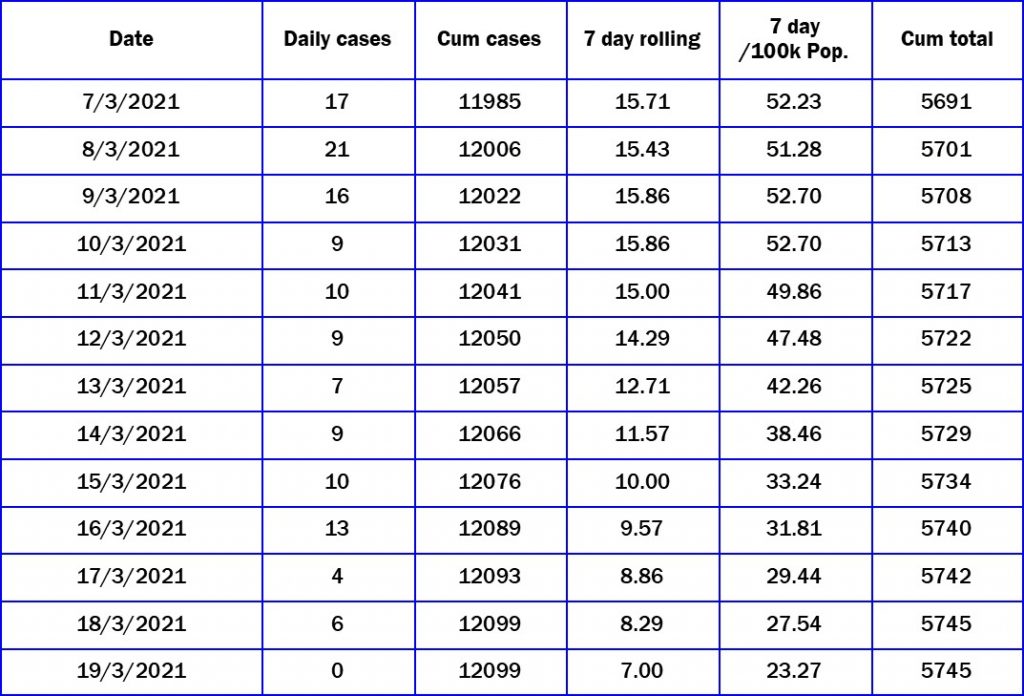
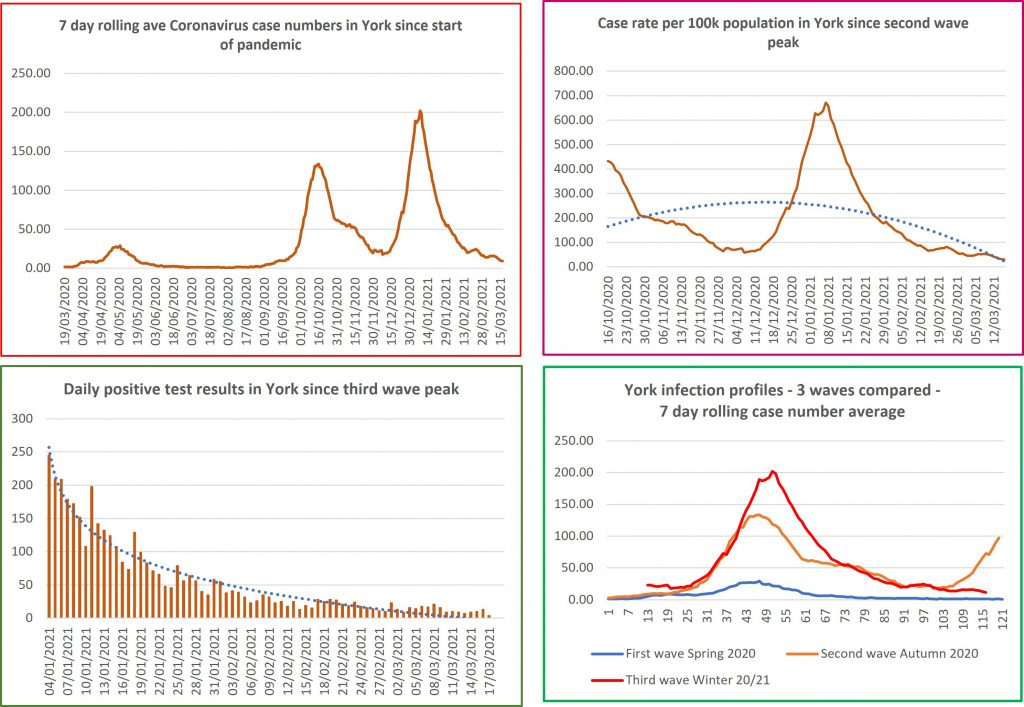
The infection rate is clearly now following a different trajectory from that seen when restrictions were eased at the end of Lockdown 2. The real test will come on 12th April when a more general easing of restrictions are expected
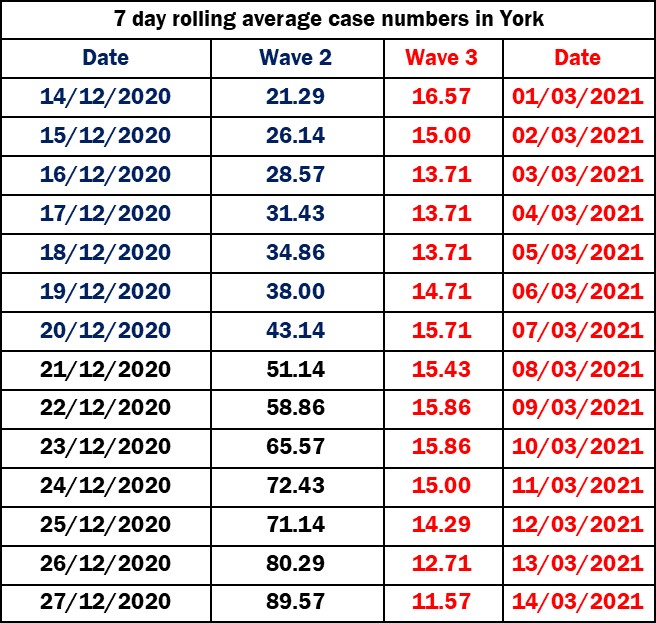
Infection rates are continuing to rise at North Yorkshire and Yorkshire levels. They are stable at a national level.
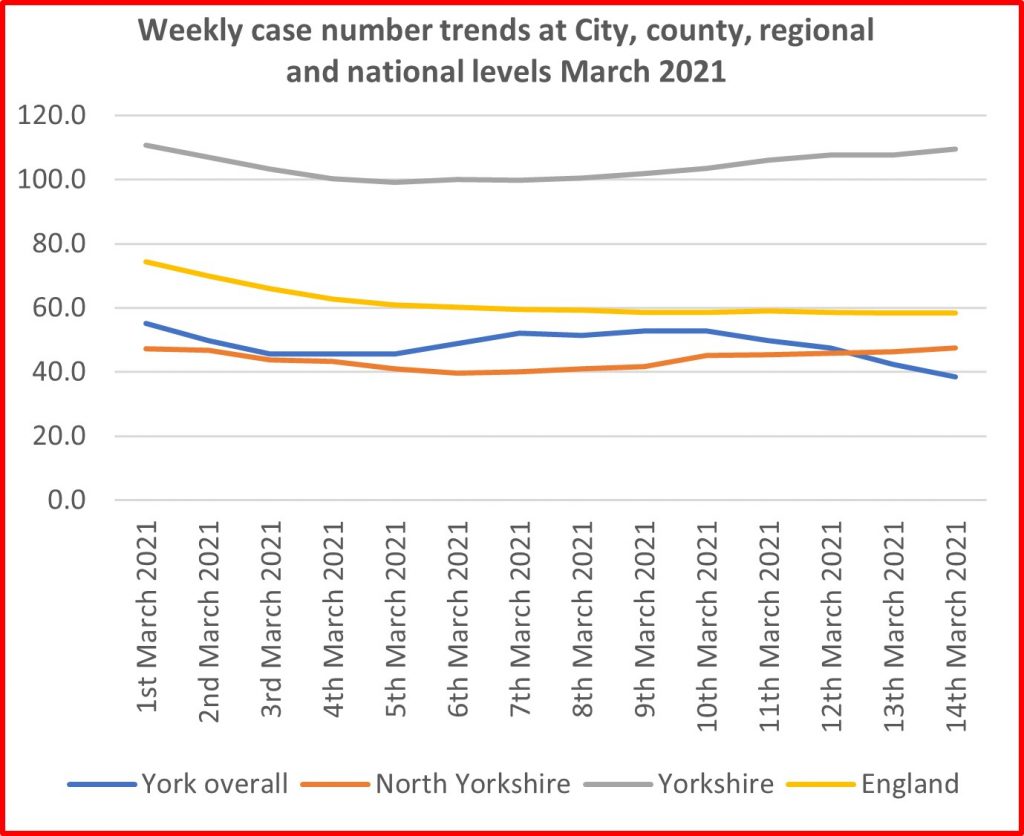
Neighbourhoods
Good news today as, for the first time since last summer, no York neighbourhood has an infection rate above 100.
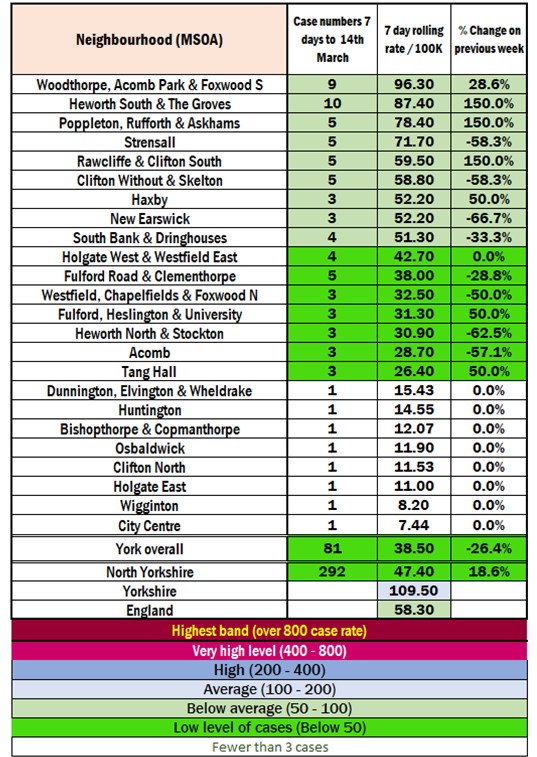
Vaccinations
Good progress with vaccinations
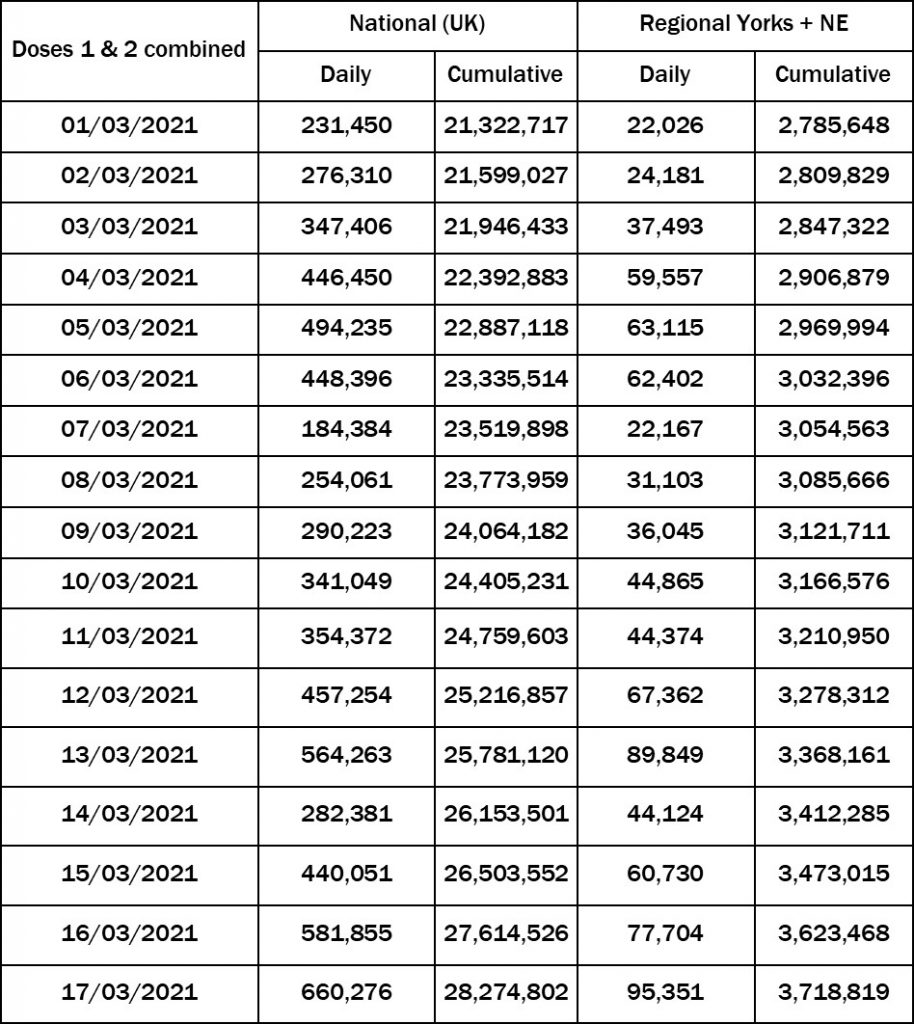
Tests
3977 PCR tests were conducted during the week ending 14th March 2021
The positivity rate was 1.4% – the same as the previous day.
3100 “lateral flow” tests were also conducted on 18th March 2021
Hospitals
The number of COVID-19 patients being treated by the York Hospital Trust has fallen to 30. Four are in intensive care. 2069 patients have been treated for coronavirus since the start of the pandemic and subsequently discharged from hospital.
Council commentary
The York Council has updated its commentary on the pandemic
It is reproduced below
The data is accurate as at 8.00 a.m. on Friday 19.03.21. Some narrative for the data covering the latest period is provided here below:
People with Covid Symptoms
• NHS Pathways/111 triages – as at 15.3.21 there had been 74 total covid triages in the CYC area in the last 7 days. The peak number of triages was 653 in the 7 day period to 20.9.20.
• As at 18.3.21, the Covid Symptom App estimates 87.3 per 100,000 in York with symptomatic covid (responses from a sample of 4,459 people). The peak rate was 1,283 on 7.1.21.
Diagnosed cases
• As at 18.3.21 York has had 12,094 cases since the start of the pandemic, a rate of 5,742 per 100,000 of population. The cumulative rate in York is below the national (6,656) and regional (6,735) averages.
• The PHE ‘Exceedance’ rating compares the no. of new cases over a 14 day period with the previous 6 weeks and provides a RAG rating to indicate if the previously observed trend in the no. of new cases is worsening. The latest rating for York (15.3.21) is Green.
• The provisional rate of new Covid cases per 100,000 of population for the period 10.3.21 to 16.3.21 in York is 31.8 (using data published on Gov.uk on 18.3.21).
• The latest official “validated” rate of new Covid cases per 100,000 of population for the period 7.3.21 to 13.3.21 was 42.3. The national and regional averages at this date were 58.3 and 107.6 respectively (using data published on Gov.uk on 18.3.21).
• York is currently ranked 61st out of 149 Upper Tier Local Authorities (UTLAs) in England with a rank of 1 indicating the lowest 7 day rate.
• For the 7 day period 6.3.21.to 12.3.21, 1 ward in York (Micklegate) has seen a statistically significant fall in rates compared with the 7 day period 27.2.21 to 5.3.21. 2 wards (Dringhouses and Woodthorpe and Hull Road) have seen a significant rise in rates. For the remaining wards there has been no significant change in rates.
• The rate of new Covid cases per 100,000 of population for the period 7.3.21 to 13.3.21 for people aged 60+ in York was 6.1. The national and regional averages were 28.0 and 41.9 respectively.
• As at 15.3.21, the latest 7 day positivity rate in York (Pillar 2 PCR tests only) was 1.28%. The national and regional averages are 2.6% and 5.1% respectively.
• As at 15.3.21 the latest 7 day positivity rate in York (Pillar 2 Lateral Flow Tests only) was 0.16%. The national and regional averages are 0.1% and 0.2% respectively.
• As at 16.3.21 the latest 7 day positivity rate in York (Pillar 1 tests only) was 0.9%. The national average is 1.4%.
• As at 18.3.21 York University reported 10 individuals within the University community who were currently self-isolating because they have had a positive COVID-19 test. The peak number was 331 on the 19.10.20.
• As at 15.3.21 York St. John reported 1 individual within the University community who was currently self-isolating because they have had a positive COVID-19 test. The peak number was 82 on the 8.10.20.
Contact Tracing
• Since 28.5.20 a total of 11,229 confirmed CYC Covid cases have been uploaded into the NHS Test and Trace system and 10,126 of the cases have been completed (90.2%). 26,095 ‘contacts’ have been identified and 19,760 of these have been completed (75.7%). Source: PHE Report.
• Local Tracing of Cases: Between 22.10.20 and 12.3.21, 981 referrals had been actioned by the local contact tracing service. Of the referrals actioned, 632 (64.4%) were successful and 349 (35.6%) were unable to be reached via phone or home visit, but guidance leaflets were posted where possible.
Cases in Residential Care Settings
• As at 18.3.21 there was 1 care home in the CYC area with confirmed Covid-19 infection (at least 1 case of either a staff member or resident).
• The latest ‘outbreak’ (2+ cases) in a residential care setting in York was reported by PHE on 25.2.21 (1 home).
Cases amongst School Aged Children
• In the 7 days up to 15.3.21 there were 22 children of primary and secondary school age who tested positive across 10 schools.
COVID Bed Occupancy in York Hospital
• As at 17.3.21 there were 17 confirmed Covid-19 patients in General and Acute beds. The peak number was 157 on 19.1.21.
• As at 17.3.21 there were 5 confirmed Covid-19 patients and 0 suspected Covid-19 patient in the Intensive Treatment Unit. The peak number for people in ITU was 19 on 10.5.20.
• As at 17.3.21 there had been 0 patients admitted with suspected Covid-19 and 0 with confirmed Covid-19 in the previous 24 hours.
• As at 17.3.21 there had been 1 confirmed patient discharged with COVID-19 in last 24 hours.
Covid Patients (CYC Residents) discharged from York Hospital
• Between 8.3.21 and 14.3.21, 9 CYC residents were discharged from York hospital after needing NHS care for symptoms linked to covid-19 infection.
R Number
• The ‘R’ value (the number of people that one infected person will pass on a virus to, on average) for the North East and Yorkshire area on 12.3.21 was estimated to be in the range 0.7 to 0.9. The previous estimate was (0.7 to 1.0) on 5.3.21.
Total Vaccinations
• As at 17.3.21 79,375 CYC residents had received the first dose and 5,724 had received both doses. 37.7% of the total estimated population of York (210,618*) had therefore received the first dose.
• As at 17.3.21 21.88M In people in England had received the first dose and 1.31M had received both doses. 38.9% of the total estimated population of England (56,286,961*) had therefore received the first dose.
*using Mid-Year 2019 population estimates
Deaths
The two sources about deaths from Covid-19 at LA level are ONS data and local registrar data. They are derived from the same source (civil registration data). ONS data is more comprehensive as it includes deaths of York residents which have occurred and been registered outside York. Local registrar data is useful as it enables a breakdown by age and gender. The most recently available data is summarised below:
• ONS weekly data: In the most recent period (Week 9: 27.2.21 to 5.3.21) 4 Covid-19 deaths were recorded as having occurred for CYC residents. In weeks 6, 7 and 8 there had been 11, 19 and 6 deaths respectively.
• ONS Cumulative data: Since the start of the pandemic, for deaths occurring up to 5th March 2021 and registered up to 13th March 2021, 378 Covid-19 deaths were recorded as having occurred for CYC residents (220 in hospital, 129 in care homes, 21 at home and 8 in a hospice). The number of deaths per 100,000 of population in York is 179.5 which is lower than the national average of 223.5
• Local Registrar data (Cumulative): Since the start of the pandemic (using data for deaths occurring up to 10.3.21), a cumulative total of 365 deaths of CYC residents where COVID-19 was mentioned (confirmed or suspected) on the death certificate, have been registered. The average age of the people who died was 82.3, with an age range of 44-104. The age profile of those dying in York is older than the national average (80.3% of those who died in York were aged 75+ compared with 73.4% nationally). 174 of the 365 were male (47.7%), less than the national average (54.3%).
Council plans to “safely reopen city”
The Council has issued the following statement in advance of a general reopening of facilities including retail on 12th April. More clarity is needed on the availability of testing services.
With infection rates in the rest of the region currently higher than in York, the Council must make representations about what – if any – recreational travel will be permitted.
There are similar questions to be answered by the Universities about their timetable for increased “on campus” learning.
“With the publication of the roadmap to recovery, the City of York Council has started planning to safely reopen the city.
In doing this, the Council will focus on prioritising the health and wellbeing of the residents of York, and supporting the economic recovery of the city.
Public Health guidance will play a key role in all decisions made for the future of the city and the council focus is on protecting residents against the immediate threat of coronavirus.
Learning from reopening activities that took place during summer 2020, when the city enjoyed a large number of visitors and relatively low number of cases, together with recognising challenges from Christmas and that reopening in 2021 is taking place in a different environment, where testing and vaccinations is more the norm.”
Keith Aspden, Leader of the Council, said:
We are working with businesses and organisations across the city to make sure that when the time comes, residents have the confidence to enjoy our city centre safely.
The health and wellbeing of residents and businesses is our immediate focus, and we look forward to welcoming visitors back to our beautiful city once restrictions are lifted. We know that York has a lot to offer, and our amazing range of independent businesses are working hard to ensure that their customers can look forward to safe services at their next visit.”
Extra measures introduced in the city will include:
- The installation of temporary public toilets in the city centre
- Extending the Covid Support Marshalls programme until the end of June
- Submitting planning applications required for temporary managed outdoor spaces
Sharon Stoltz, Director of Public Health, said:
Whilst many people will be looking forward to the easing of restrictions we must all remember that COVID-19 remains a part of our lives.
“We want to make sure that York is a safe city for all our residents to enjoy, and we need the support of residents and communities to make that happen. We are working closely with the Public Health England Behavioural science team to iteratively improve how we can keep residents, staff and visitors safe.
“For now we must carry on with ‘hands, face, space’, comply with the COVID-Secure measures that remain in place, meet outdoors when we can and keep letting fresh air in. We should get tested when needed and get vaccinated when offered. If we all continue to play our part, we will be that bit closer to a future that is more familiar.”
To help businesses safely manage outside space and better understand how to keep their consumers and staff safe by prompting COVID-19 safe behaviours, the council are working with Public Health England’s behavioural insight team in the run up to reopening the city.
They will be hosting a free webinar on Thursday 25 March, where the Public Health team will answer questions from businesses. Tickets can be booked online.
Plans to meet York’s post-pandemic skills needs to be considered
Plans to address the skills and training needs of York residents and businesses as they recover from the covid-19 pandemic will be discussed next week at a Decision Session for the Executive Member for Economy and Strategic Planning (23 March).
Cllr Andrew Waller will be asked to endorse proposals put forward by the city’s Skills and Employment Board* to tackle the immediate impact of the pandemic.
One-year plan: Skills for Employment in York, sets out how the city needs to respond to the changing skills and training needs of the city post-pandemic. The aim is to ensure that residents and businesses have the necessary skills and training support to meet their needs, helping York’s economy to recover, and grow, over the coming years.
The plan builds on a wide range of skills support that has been developed since the early stages of the first lockdown. Skills and education partners across the city have been working together to help people through change; aligning, adapting and communicating the support available to both individuals and businesses.
Skills for Employment in York sets out five shared commitments:
• York works – skills support for individuals
Supporting those entering, re-entering or displaced from the workforce to re-train or upskill and connect them with good jobs in sustainable and growth sectors.
• Empowered employers – skills support for businesses
Supporting businesses of all sizes to access national, regional and local skills provision to help them plan, diversify and grow.
• Pioneering provision – productive partnerships
Working in partnership to make the most of national, regional and local initiatives and adapt local skills provision in response to emerging needs.
• Education to employment and self-employment – York’s pipeline
Supporting positive progressions for all by preparing those transitioning from education or re-entering the world of work for a culture of lifelong learning and entrepreneurship.
• York shares – communicating the offer
Developing a coherent and effective marketing and communications strategy to ensure information advice and guidance is provided at the point of need in a timely and effective way.
Cllr Andrew Waller, Executive Member for Economy and Strategic Planning, said: The economic impact of the pandemic is being felt across many sectors in the city, and some have been severely hit, leading to job losses.
“As York’s employment changes it is vital that support and training is available to help individuals who need it. This includes those joining the workforce from school or college, or who are older and have lost their job and are looking to find a new career. Businesses are looking to get ready for new opportunities, especially with cleaner greener jobs, and we need to make sure the local workforce has the skills needed for this.
“The one year plan is part of a wider ten year strategy which aims to ensure that York, its residents and businesses, are well placed to recover from the impact of the pandemic.
“I’d like to thank the city’s Skills and Employment Board for developing the one year plan, and their ongoing work on the ten year skills strategy. Their hard work engaging with businesses, council and skills providers underlines the commitment of partners across the city to supporting York’s future skills and training needs. “

